Munich
![]()
The title of this article is ambiguous. For other meanings, see Munich (disambiguation).
Munich (High German [![]()
![]() ˈmʏnçn̩] or [ˈmʏnçən]; Bavarian
ˈmʏnçn̩] or [ˈmʏnçən]; Bavarian ![]() [ˈmɪŋ(ː)ɐ]) is the capital of the Free State of Bavaria. It is the most populous city in Bavaria with 1,488,202 inhabitants (December 31, 2020), the third largest municipality in Germany, and the most densely populated municipality in Germany with 4790 inhabitants per square kilometer. The city forms the center of the Munich metropolitan region (about 6.12 million inhabitants) and the Munich planning region (2.93 million inhabitants).
[ˈmɪŋ(ː)ɐ]) is the capital of the Free State of Bavaria. It is the most populous city in Bavaria with 1,488,202 inhabitants (December 31, 2020), the third largest municipality in Germany, and the most densely populated municipality in Germany with 4790 inhabitants per square kilometer. The city forms the center of the Munich metropolitan region (about 6.12 million inhabitants) and the Munich planning region (2.93 million inhabitants).
Munich is counted among the world cities and is considered a center of culture, politics, sciences and media. It is home to numerous corporations, including six DAX-listed companies (Allianz, BMW, Munich Re, Siemens, MTU and Siemens Energy). Bavaria's only stock exchange is located here. In the 2018 city rankings by consulting firm Mercer, Munich ranked third among 231 major cities worldwide in terms of quality of life. According to Monocle magazine, it was the world's most livable city in 2018. On the other hand, the quality of life is increasingly limited by agglomeration disadvantages such as traffic and environmental pollution as well as very high residential property prices and real estate rents, which is why the living space per inhabitant is far below the national average. With 6,469 criminal offenses per 100,000 inhabitants in 2019, Munich is considered the safest municipality among major German cities with over 100,000 inhabitants in terms of the crime rate for all criminal offenses.
Munich was first mentioned in documents in 1158. The city became a Bavarian ducal seat in 1255 and was a royal seat from 1314 and an imperial seat from 1328 to 1347. In 1506, Munich became the sole capital of Bavaria. Munich is the seat of numerous national and international authorities as well as important universities and colleges, important museums and theaters. Due to a large number of buildings worth seeing including protected monuments and ensembles, international sporting events, trade fairs and congresses as well as the world-famous Oktoberfest, the city is a center of attraction for international tourism. Under administrative law, Munich is an independent city. The city is the seat of the Bavarian state parliament, the Bavarian state government, the administrative seat of the Munich district surrounding the city with its district administration office as well as the Bavarian district of Upper Bavaria and the administrative district of Upper Bavaria. In addition, Munich is the seat of several state authorities and some federal authorities and courts.
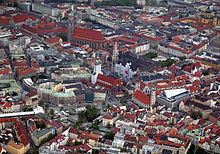
Aerial view of Munich old town with Marienplatz, New Town Hall, Frauenkirche and Viktualienmarkt

Aerial view of the center of Munich (view to the east)
Official logo of the Bavarian capital Munich

Alpine scenery behind Munich (view from Olympic Park)
Etymology
The name Munich is usually interpreted as "near the monks". The name is first mentioned as forum apud Munichen in the Augsburg Schied of 14 June 1158 by Emperor Frederick I. Munichen is the dative plural of Old High German munih or Middle High German mün(e)ch, the precursor of New High German Mönch.
Before the founding of the city, there is said to have been a settlement of monks here. The fact that this was located on Petersbergl, as is often claimed, has not yet been confirmed by archaeological finds. According to another hypothesis, the monks' settlement that gave the town its name (Klosterhof Schäftlarn) was located on the site of today's St. Michael's Church. An earlier assumed connection to the Tegernsee monastery has been considered disproved for some time.
It is not certain whether a monk settlement existed when Munich was founded. Furthermore, it is possible that munichen already represented a fixed place name at that time, which in turn already went back to an earlier, no longer existing monk settlement. Occasionally it has been doubted that the name munichen refers to a monk settlement at all.
The Middle Latin name of the city is Monacum, adjective monacensis; Monachia or Monachium are also attested.
Munich has different names in other languages: Thus, the city is called Munich in French and English (each with a different pronunciation), Múnich in Spanish, Munique in Portuguese, Monaco (di Baviera) in Italian ("di Baviera" to distinguish it from Monaco in the principality of the same name), Mnichov in Czech, and Monachium in Polish.
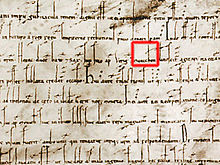
First documentary mention of Munich (munichen) in the Augsburg Schied
Geology
The Alpine foothills between the Limestone Alps and the Danube, in which Munich is also located, lie on a deep subsidence basin that has been filled for millions of years, mainly from erosion from the Alps. In the Tertiary period, mainly sand and rubble masses were deposited there by rivers from the Alps. During the subsequent ice ages, the last of which ended about 10,000 years ago, large glacial and meltwater streams formed in the Alpine region, leaving behind moraine hills and gravel plains in the foothills of the Alps. The 55 km wide Munich gravel plain, which starts at the terminal moraines of the Isar foreland glacier, is a sloping plain with an elevation difference of 300 meters between Holzkirchen in the south and Moosburg in the north, whose surface forms are primarily formed by the Würm Ice Age gravel. In the south of the plain, rivers, especially the Isar, are deeply incised. On these gravel soils, as in the south of Munich, one finds more forests, such as Perlacher Forst and Forstenrieder Park, partly because the groundwater table is relatively low here. In the north of the city, on the other hand, where the groundwater table is close to the surface, there are large fens, such as the Dachauer Moos in the northwest and the Erdinger Moos in the northeast. See also: Munich Green Belt.
Topography
Terrain
The average altitude is 519 m above sea level. The highest point in Munich is located at the extreme southern city limits in the Solln district. It is located about 600 meters south of the Warnberg estate (about 579 m above sea level) directly south of two soccer fields located at the edge of the Forstenrieder Park forest at 580.5 m above sea level.
The lowest point is near the extreme northern city boundary in the district of Feldmoching at the Oberschleißheim regatta course, which is located to the east of the Schwarzhölzl nature reserve and forest area and lies at around 480 meters above sea level. This results in an altitude difference of about 100 meters in the city area.
Waters
The Isar flows through the city area from southwest to northeast over a length of 13.7 km, with the Isar-Werkkanal running parallel to it as far as Sendling. In the Isar lie the Museum Island with the German Museum and in the immediate vicinity downstream the Prater Island. In the southern parts of the city, the Isar is strongly cut into the gravel plain, with steep edges on both sides. The lower-lying district of Thalkirchen is located where the left terrain step away from the Isar. The step is even more visible in Sendling and on the west side of Theresienwiese. On the right bank of the Isar, the Tierpark and the Au district are below the terrain step, which approaches the river again near the city center (Gasteig = gacher [steep] Steig; ramps prominent in urban planning at the Maximilianeum and Friedensengel) before the difference in elevation gradually disappears in the northern district of Oberföhring.
Other watercourses include the Würm, which flows through the west of Munich from Lake Starnberg, the Hachinger Bach, which enters the city in the southeast near Perlach and continues underground north of Neuperlach, and several city streams branching off the Isar, such as the Eisbach and the Auer Mühlbach.
→ Main article: Munich city streams
Lakes in the Munich city area include Kleinhesseloher See in the English Garden, Badenburger See and Pagodenburger See in Nymphenburger Park, Olympiasee, Nadisee, Schwabinger See, the Dreiseenplatte with Lerchenauer See, Fasanerie See and Feldmochinger See in the north and, in the west, Langwieder See and Lußsee, which belong to the Langwieder Seenplatte. In the south, near the left bank of the Isar River, is Hinterbrühler See. In recent times, the Riemer See was created in the east.
See also: List of water bodies in Munich
Extension
The total area of Munich is 310.7191 square kilometers. Of this, 44.6 percent is buildings and associated open space, 17.0 percent is transportation land, 14.7 percent is agricultural land, 15.7 percent is recreational land, 4.4 percent is forest land, and 1.5 percent is water. In addition to land allocated to buildings, the percentage of recreational land, forest land, and water land has also increased since 2007, while that of transportation and agricultural land has decreased. The changes over this period were each less than one percent, with the largest absolute change (0.8 percent of the city's land area) being in agriculture. In contrast, the relative increase in water areas of about 14 percent was the largest (as of December 31, 2019). The city's boundary covers 118.9 kilometers. The largest extension of the city area is 20.7 kilometers from north to south and 26.9 kilometers from east to west (as of December 31, 2007).
Enlargement through incorporations
→ Main article: Incorporations into the city of Munich
Like other large cities, Munich repeatedly expanded by incorporating surrounding, formerly independent smaller towns and communities. In Munich, these incorporations took place in several stages between 1853 and 1942. The few expansions of the urban area before 1854 were not carried out by incorporations, but by genuine expansion of the urban area at the expense of generally unpopulated surrounding areas. After the Second World War, there were no more incorporations, but there were still three enlargements of the urban area at the expense of neighboring municipalities without their abolition (1954, 1962, 1967). Conversely, in 1951, a part that had been incorporated as recently as 1942 was again excluded from the urban area.
City breakdown
→ Main article: List of Munich's boroughs and List of Munich's districts.
The city area is not divided into districts in the municipal law sense, but - exclusively - into city boroughs. Their number had risen to 41 by World War II and was reduced to the current number of 25 in a reorganization in 1992 and 1996. In everyday usage, Munich residents tend to refer to the historically grown districts and neighborhoods.
For statistical purposes, the 25 city districts are subdivided into a total of 105 city district parts. Below the subdivision level of the city district parts, there are the 475 city district quarters. These are divided into building blocks at the lowest level. A building block is a spatially contiguous area of land that is bounded on as many sides as possible by streets, roads, railroad lines, watercourses or other prominent topographic lines and is not intersected. Building blocks do not have names, and only half of the borough's neighborhoods (237 of 475) have names.
As of the effective date of January 1, 2011, a reclassification of the city district parts and city district quarters took place.
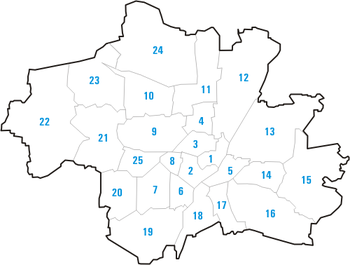
![]()
· 
Königsplatz in the Maxvorstadt
· 
View of Ludwigsvorstadt
· 
Max Weber Square in Au-Haidhausen
· 
Residential ring in Ramersdorf-Perlach
| Munich population in the 25 city districts as of December 31, 2019 | |||||
| No. | Municipality | Area | Inhabitants | Density | Foreigners |
| 01 | Old Town-Lehel | 03,15 | 021.126 | 06.716 | 26,0 |
| 02 | Ludwigsvorstadt-Isarvorstadt | 04,40 | 051.933 | 11.799 | 28,3 |
| 03 | Maxvorstadt | 04,30 | 051.834 | 12.060 | 25,6 |
| 04 | Schwabing-West | 04,36 | 068.935 | 15.800 | 22,8 |
| 05 | Au-Haidhausen | 04,22 | 061.654 | 14.611 | 23,5 |
| 06 | Sendling | 03,94 | 041.256 | 10.475 | 27,2 |
| 07 | Sendling-Westpark | 07,81 | 060.498 | 07.742 | 29,5 |
| 08 | Schwanthalerhöhe | 02,07 | 029.611 | 14.303 | 32,6 |
| 09 | Neuhausen-Nymphenburg | 12,91 | 100.213 | 07.760 | 24,9 |
| 10 | Moosach | 11,09 | 054.872 | 04.946 | 32,2 |
| 11 | Milbertshofen-Am Hart | 13,42 | 076.559 | 05.706 | 41,3 |
| 12 | Schwabing-Freimann | 25,67 | 078.657 | 03.064 | 29,6 |
| 13 | Bogenhausen | 23,71 | 090.025 | 03.797 | 24,9 |
| 14 | Berg am Laim | 06,31 | 047.000 | 07.443 | 32,7 |
| 15 | Trudering-Riem | 22,45 | 073.479 | 03.273 | 23,4 |
| 16 | Ramersdorf-Perlach | 19,90 | 117.918 | 05.927 | 34,4 |
| 17 | Obergiesing-Fasangarten | 05,72 | 054.498 | 09.527 | 31,3 |
| 18 | Untergiesing-Harlaching | 08,06 | 053.243 | 06.609 | 24,2 |
| 19 | Thalkirchen-Obersendling-Forstenried-Fürstenried-Solln | 17,76 | 097.689 | 05.500 | 27,8 |
| 20 | Rag | 09,22 | 050.165 | 05.439 | 28,0 |
| 21 | Pasing-Obermenzing | 16,50 | 076.348 | 04.628 | 23,9 |
| 22 | Aubing-Lochhausen-Langwied | 34,06 | 049.072 | 01.441 | 29,5 |
| 23 | Allach-Untermenzing | 15,45 | 034.277 | 02.218 | 25,1 |
| 24 | Feldmoching-Hasenbergl | 28,94 | 062.069 | 02.145 | 32,8 |
| 25 | Laim | 05,29 | 057.111 | 10.804 | 29,0 |
| City of Munich | 310,710 | 1.560.0420. | 05.021 | 28,5 | |
Neighboring communities
The following cities, municipalities and municipality-free areas border the city of Munich (listed clockwise, starting in the north):
- Munich County:
Oberschleißheim, Garching bei München, Ismaning, Unterföhring, Aschheim, Feldkirchen, Haar, Putzbrunn, Neubiberg, Unterhaching, Perlacher Forst (municipality-free area), Grünwald, Pullach im Isartal, Forstenrieder Park (municipality-free area), Neuried, Planegg, Gräfelfing
- Fürstenfeldbruck County:
Germering, Puchheim, Gröbenzell, Olching
- Dachau district:
Karlsfeld, Bergkirchen
Climate
The city of Munich lies in the transitional area between the humid Atlantic maritime climate and the dry continental climate; a cool temperate climate prevails (border Cfb/Dfb). Winters are comparatively cold, but temperatures below -20 degrees Celsius are rare. Summers, on the other hand, are also comparatively warm, with temperatures ranging from 20 to 35 degrees Celsius, making Munich one of the warmest German regions in summer, apart from the regions in the Rhine rift valley. Other major weather-determining factors are the Alps as the Central European and the Danube as the regional weather divide. Due to this constellation, the weather is relatively changeable. On an average of ten days a year, there is the Föhn, a warm, dry downdraft wind from the main ridge of the Alps, which causes such good long-distance visibility that the Bavarian Alps can be clearly seen from the city area. More frequently, there are so-called "foehn effects", which are föhn effects in a weaker form.
The highest temperature so far officially measured by the German Weather Service at the official DWD weather station in Munich city was 37.5 °C on July 27, 1983. The coldest record is -31.6 °C, measured in the Botanical Garden on February 12, 1929. The annual mean temperatures in the reference period 1961-1990 were between 7.8 °C in Riem and 9.1 °C in the city center; they rose at the city station to 9.7 °C in the climate period 1981-2010. Due to its location within Upper Bavaria, which is one of the regions with the most thunderstorms in the Free State as well as in all of Germany, Munich has been hit by severe storms on several occasions. Particularly noteworthy is the hailstorm of July 12, 1984, which caused damage amounting to DM 3 billion. Due to its proximity to the Alps, Munich is the city with the most snow in Germany.
An analysis of weather statistics has shown that the southern part of the city is the sunniest. In the northern part fog occurs relatively often. The western half has less precipitation than the eastern part of the city. This is basically also a consequence of the differences in altitude within the city, which generate a corresponding microclimate, favored by the separation of the city into east and west by the Isar River.
| Munich | ||||||||||||||||||||||||||||||||||||||||||||||||
| Climate diagram | ||||||||||||||||||||||||||||||||||||||||||||||||
| ||||||||||||||||||||||||||||||||||||||||||||||||
| Monthly average temperatures and precipitation for Munich
Source: DWD, data: 2015-2020; wetterkontor.de, data: mostly 1961-1990 | |||||||||||||||||||||||||||||||||||||||||||||||||||||||||||||||||||||||||||||||||||||||||||||||||||||||||||||||||||||||||||||||||||||||||||||||||||||||||||||||||||||||||||||||||||||||||||||||||||||||||||||||||||||||||||||||||||||||||||||||||||||||||||||||||||||||||||
Climate change
In Munich, the general trend of temperature warming by about one degree Celsius of the average annual temperature in Germany over the last 120 years can also be observed. In November 2016, the full city council decided that an increase in average temperature, an increase in heat extremes, an increase in the number of hot days and nights with a temperature above 20 degrees Celsius (tropical nights), a change in precipitation patterns, and an increase in local heavy rainfall events are among the climate changes to be expected. Against this background, the city administration, through the Department of Health and Environment (RGU), has initiated a study in cooperation with the German Weather Service (DWD) to obtain local weather data in this context. The data is to be incorporated into the design of a concept of measures for adapting to climate change in the state capital of Munich and the Integrated Program of Action for Climate Protection in Munich (IHKM), which is to guide decisions on issues such as settlement structure and density, building development and greening, or well-functioning air exchange in the metropolis.
In December 2019, the Munich City Council adopted the climate emergency for Munich and at the same time instructed the city administration to develop an action plan on how to achieve the goal of climate neutrality for the city of Munich in 2035. Contrary to the climate emergency in Munich, the members of the Social Committee, who are members of the Board of Trustees of the Heiliggeistspital Foundation, voted in favor of further forest clearing in Forst Kasten on May 20, 2021. In May 2021, people protested for the Forst Kasten. This involved a vigil and repeated tree houses being erected and cleared by police.
Protected areas
Munich has a number of nature and landscape conservation areas both distributed over the city area and adjacent to it. In addition, there is the geotope Aubinger Lohe (No. 162R001).
Nature reserves
There are four nature reserves in Munich:
- Allacher Lohe (NSG-00573.01)
- Armored meadow and hardwood (NSG-00611.01)
- Blackwood (NSG-00460.01)
- Southern Fröttmaning Heath (NSG-00100.134)
Protected landscape areas
In Munich there are 20 landscape conservation areas , for example:
- Langwieder Autobahnsee (LSG-00120.01)
- Aubinger Lohe and Moosschwaige (LSG-00120.02)
- Allacher Forest (LSG-00120.06)
- Kapuzinerhölzl (LSG-00120.07)
- Isarauen (LSG-00120.09)
- Forest Cemetery and Fürstenried Palace and Palace Park (LSG-00120.15)
- Deer Garden (LSG-00120.16)
- Nymphenburg with canal and park remains in the northwest (LSG-00588.01)
- Forstenrieder Park (The current district of Forstenried was incorporated in 1912 (municipal district 19). The forest lies outside the city limits in municipality-free territory).
- Forest box (LSG-00114.01)
- Perlacher and Grünwalder Forst (LSG-00534.01)
See also the lists of nature reserves, landscape conservation areas and FFH areas in the city of Munich or Munich Green Belt.
Environmental protection
The legally permitted limit value of 40 μg/m³ for air pollution by the harmful nitrogen dioxide (NO2) is clearly exceeded in Munich. The main cause of nitrogen dioxide pollution is motor vehicles, especially diesel vehicles. In October 2012, the Bavarian Administrative Court legally obliged the Free State of Bavaria to revise the Clean Air Plan, Since 2011, the value of 85 μg/m³ has been reduced to 78 μg/m³ in 2017. This means that the value remains at a high level. In 2017, Munich became the city with the highest nitrogen dioxide pollution in Germany for the first time. In 2018, Munich was still the city with the third-highest nitrogen dioxide pollution in Germany.
Flora
The flora and also fauna of Munich belong to the Holarctic region. The area of the city would naturally be covered mainly by forests, with beech-dominated mixed forests predominating. However, about a quarter of the historically documented native plant species are now extinct. Currently, 1631 species have been recorded by the Flora München Group, but about 25 percent of these are newcomers and did not originally occur in the city area. Nymphenburg Park is particularly well recorded and rich in species; with 662 species, this is the highest number of species per grid field to date. A total of 2034 plant species have been documented in Munich's urban area, 1182 of which are native species. In the meantime, however, the number is increasing again. Climate change is also altering the city's flora.
In Munich, a tree protection ordinance protects trees that have a trunk circumference of 80 cm and more (measured at 1 m above the ground). In landscape protection areas, on the other hand, a landscape protection ordinance protects all woody plants.
Fauna
The Bavarian dwarf lidded snail is found only in Munich. The species was discovered in the 1980s.
The so-called city pigeons divide the urban society due to the pollution they cause. The City of Munich is trying to help reconcile the problem with a comprehensive concept that ranges from public relations work and advice to the establishment of pigeon houses.
According to the city's Department of Health and Environment, rats and mice are widespread throughout the city as cultural followers of humans. The rodents prefer to settle where people live and where food can be found, for example also in the leisure and recreation areas of the city center.
The number of dogs registered in Munich is on the rise and amounted to 36,347 animals as of December 31, 2017, of which 35,948 were taxed as pets.
Climate change has also brought Munich newcomers to the city's fauna, which usually only feel at home in tropical Mediterranean temperatures. Other species, in turn, suffer from milder winters and persistent drought.

Panoramic view of Munich city center taken from the Olympic Tower. In the foreground Luitpoldpark and Olympiapark, top left the English Garden.

The Olympic Lake in the Olympic Park
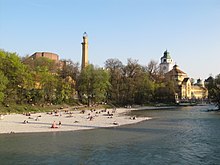
The small Isar in Munich at the Müllerschen Volksbad

Satellite photo of Munich region
Population
Population development
→ Main article: Population development of Munich
In 1852, the population exceeded 100,000, making Munich a major city. After that, the number of inhabitants rose sharply due to population growth and the incorporation of previously independent settlements, so that by 1883 Munich was already home to 250,000 people. By 1901, the population had doubled to about 500,000, making Munich the third-largest city in the German Empire after Berlin and Hamburg. In 1933, the population rose to 840,000 and in 1957 to over one million. The first peak in the number of inhabitants occurred in the Olympic year with 1,338,924 on December 31, 1972.
From 1973 onward, the population rose and fell continuously. The low point was reached in 1998 with a reported population of 1,188,897. However, a stable upward trend established itself from around the year 2000. In May 2015, according to its own estimate, which deviates from that of the Bavarian State Statistical Office, the 1.5 million mark was exceeded for the first time. Subsequently, a child born on May 8 was determined by lot to be the one-and-a-half millionth Munich resident. On September 30, 2016, the city's own estimate was that 1,537,987 residents had their primary residence in Munich.
With 4790 inhabitants per square kilometer on December 31, 2020, Munich today has the highest population density of all German municipalities.
As of December 31, 2019, approximately 2.93 million people lived in the Munich planning region, and 6.12 million people lived in the Munich metropolitan region (i.e., Upper Bavaria and parts of the administrative districts of Lower Bavaria and Swabia).
Munich is one of the few German cities where the number of newborns exceeds the number of deaths. In recent years, the number of newborns has grown very strongly. In 2009, more children were born in Munich than at any time since 1969. Added to this is strong immigration from Germany and abroad.
In 2013, 125,346 new registrations of immigrants were recorded in the Munich district administration office. In 2016, 18,107 newborns were born in Munich. This is almost 1,000 more than in the previous year and a new record.
Between 1988 and 2018, the county seat grew by 259,891 residents, or 21.5 percent, from 1,211,617 to 1,471,508.
Population structure
In May 2015, Munich recorded a proportion of foreigners (registered residents without German citizenship) of 26.8 percent. In May 2014, the proportion was 25.8 percent and in 2012 it was 24.6 percent.
The largest groups of foreigners registered in Munich according to registration laws (as of December 31, 2018) come from Croatia (38,137), Turkey (37,876), Italy (27,821), Greece (26,560), Austria (21,046), Bosnia and Herzegovina (19,692), Poland (19,101), and Romania (17,980).
According to the 2011 census, the share of the population with a migration background (registered residents with German citizenship and foreign origin at the same time) was 34.3 percent (comparison: Berlin 28 percent and Hamburg 31 percent), one of the highest values among major German cities.
The 2017 Purchasing Power Study by market research institute GfK shows that residents in the Munich metropolitan area have Germany's highest purchasing power. All Munich residents together can spend a total of 43.708 billion euros a year. This puts the Munich metropolitan area just ahead of Hamburg, although the Hanseatic city has almost 340,000 more inhabitants. Only Berlin, with around two million more inhabitants than Munich, has a higher purchasing power total as a single regional authority.
In Munich, about 1000 people are affected by homelessness and live on the streets.
Dialect
The Munich dialect belongs to the Middle Bavarian dialect. Due to the strong influx from other areas of Germany and because dialect speakers no longer pass it on to their own children, it is now threatened with extinction. As the Bavarian Ministry of Culture informed the state parliament in January 2001, the dialect of the state capital was already foreign to the inhabitants under the age of 20 at that time.
In dialect, the town is called Minga; however, this form has become uncommon in the urban vernacular, where it has been supplanted by the standard German equivalent, and is practically only used in the surrounding countryside.
Religions
→ Main article: Religions in Munich
Munich has been the seat of the Archbishopric of Munich and Freising since 1817, which was founded in that year as the successor to the prince-bishopric of Freising, which was secularized in 1803. Among the oldest Protestant churches are St. Matthew's and St. Mark's. Munich has a Jewish community of about 9,700 members, most of whom today are of Eastern European origin (Ukraine and Russia), and a smaller liberal Jewish community.
Overall, 3.6 percent were members of a Christian Orthodox church in 2011, and another 4.4 percent belonged to other religious communities under public law recognized in Bavaria (in addition to the major official churches).
The church of Maria Schutz and St. Andrew in the Untergiesing district of Munich, consecrated in 1976, is the cathedral of the Apostolic Exarchy for Catholic Ukrainians of the Byzantine rite in Germany and Scandinavia, which has existed since 1959. The Munich seat of the Exarchy dates back to the large number of Ukrainian forced laborers who had been brought to Bavaria during World War II and remained there, first as displaced persons and later, in some cases, permanently. In June 1945, the Ukrainian Orthodox Church of St. Mary Protection was founded. Since the congregation initially numbered more than 5,000 members, a second parish dedicated to the Apostles Peter and Paul was founded in the Ludwigsfeld district of the city, which still exists today.
Ungererstrasse 131 in Schwabing-Freimann is home to the parish center of Munich's Greek Orthodox community and the All Saints' Church. From May 12 to 16, 2010, the second Ecumenical Church Day took place in Munich.
It is assumed that there are around 100,000 to 120,000 Muslims living in Munich, which corresponds to seven to eight percent of the population. Bavaria's first mosque, inaugurated in 1973, is located in the Freimann district. In 2005, the controversy surrounding a new construction project for a mosque in Sendling also became known nationwide under the catchword "Sendling Mosque Controversy." Under the leadership of Imam Benjamin Idriz, a large mosque including a cultural center and training center for imams was to be built in Munich, initially under the name "Center for Islam in Europe - Munich" (Ziem). The project has since been renamed the "Munich Forum for Islam" (MIF).
Jehovah's Witnesses are represented by 59 congregations in Munich, which operate 16 Kingdom Halls and Hall Centers in the city area. There is also a Jehovah's Witnesses congress hall on Riesstraße in Moosach, where supraregional meetings are held regularly.
The Free Church of the Seventh-day Adventists is represented by nine congregations and houses in the city area. The Bavarian headquarters of the free church is also located in Tizianstraße in Neuhausen-Nymphenburg.
The Church of Jesus Christ of Latter-day Saints is represented in Munich by four congregations in two community centers.
The Association of Mandaeans in Germany, based in Munich, is concerned with the establishment of a functioning Mandaean community.
The Krishna Temple on Wachenheimer Strasse in Munich-Giesing, which has been in existence for several decades, has developed into an important place of worship for around 15,000 Hindus living in Munich. Meditation and Hindu festivals such as the festival of lights Diwali are celebrated there.
City Saints
The city's first patron saint was St. Onuphrios, a Syrian-Egyptian hermit of the 3rd century, whose relic in the form of a brainshell was supposedly brought to Munich by Henry the Lion (1129-1195) from a crusade against the Wends.
Since 1580, St. Benno, who was Bishop of Meissen from 1066 to 1106, has been venerated in the Roman Catholic Church as the patron saint of Bavaria and the city of Munich.
Denomination statistics
As of December 31, 2020, of the 1,562,096 residents, 29.1 percent were Roman Catholic, 10.4 percent were Protestant, and 60.5 percent (945,047) belonged to other religions or were nondenominational. At the end of 2018, 30.9 percent of residents were Roman Catholic, 11.1 percent were Protestant (including Protestant Free Churches), 0.3 percent were Jewish, while 57.7 percent either belonged to other denominations or religions or were nondenominational. Accordingly, the number of Protestants and Catholics decreased during the observed period, while the proportion of nondenominational persons increased. Until 2000, Catholics were the strongest population group. Although the group of non-denominational people is significantly larger than that of Catholics, Munich is one of the Bavarian cities and municipalities in which the Assumption of the Virgin Mary (August 15) is a public holiday.
| Religious and denominational affiliation of the population in the state capital Munich (in percent) | ||||||||
| 1961 | 1987 | 2011 | 2014 | 2015 | 2016 | 2017 | 2020 | |
| Roman Catholic | 71,8 | 58,0 | 39,9 | 33,9 | 33,1 | 32,4 | 31,8 | 29,1 |
| evangelical(a) | 22,6 | 19,1 | 15,2 | 12,3 | 11,9 | 11,6 | 11,4 | 10,4 |
| muslim | - – | 04,0 | 07,4 (b) | 08,4 (b) | - – | - – | - – | _ |
| christian-orthodox | - – | - – | 03,6 | - – | - – | - – | - – | _ |
| jewish | - – | - – | 00,3 | 00,3 | 00,3 | 00,3 | 00,3 | |
| other denominationsand | 05,6 | 18,9 | 33,6 (c) | 45,1 | 54,7 | 55,7 | 56,5 | 60,5 |
(a) 1987: only Evangelical Lutheran Church, 1961 and from 2011: including Evangelical Free Churches.
(b) Estimates
(c) Including 4.4 percent who belong to other recognized religious communities under public law (Old Catholic Church, Jehovah's Witnesses, etc.).
Personalities
→ Main article: List of personalities of the city of Munich and List of honorary citizens of Munich.
The Munich City Council may appoint honorary citizens to persons who have rendered outstanding services to the welfare of the city.
Sons and daughters of the city are persons born in Munich, regardless of whether they had their later sphere of activity in Munich or not. In addition, there are personalities born outside Munich who lived and worked in the city.
Monuments have been erected to some personalities, such as the fountain monuments at the Viktualienmarkt for famous folk actors and folk singers. Monuments have also been erected to popular fictional characters from film and television who help shape the city's image abroad, such as Helmut Dietl's Munich original Monaco Franze or Ellis Kaut's leprechaun Pumuckl.

Population development of Munich from 1871 to March 2017

Catholic Parish Church of St. Maximilian seen from the Old Peter
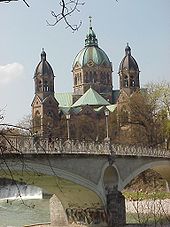
Protestant parish church of St. Luke with cable bridge
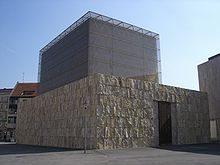
New main synagogue at St. Jacob's Square
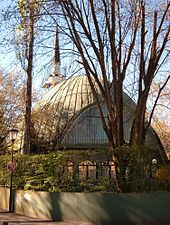
Mosque in the north of the Freimann district in Auensiedlung
.jpg)
St. Onophrios, fresco in Blutenburg Castle
History
→ Main article: History of Munich
City foundation
Munich was first mentioned in documents in 1158 as forum apud Munichen in the Augsburg Schied, after the Duke of Bavaria and Saxony Henry the Lion had built a crossing of the salt road over the Isar approximately at the site of today's Ludwigsbrücke and founded a market near the crossing.
However, the Augsburg Arbitration did not establish the city of Munich; as a result, the already existing settlement was only granted market, minting and customs rights by Emperor Frederick Barbarossa. The Freising bishops, however, received one third of the resulting revenues.
When the city of "Munich", which came into the light of history from 1158, was actually founded and what name the settlement bore at its foundation is not known. The oldest and at that time still the only parish church in the city is St. Peter's Church.
Middle Ages: ducal seat and imperial residence
When Henry the Lion was outlawed by the emperor in 1180, Bavaria fell to the Wittelsbach dynasty and Munich to the Bishop of Freising. In 1240, Munich also came into Wittelsbach possession and became a ducal residence as early as 1255 after the first division of the land.
Since 1314 Duke Ludwig IV was German King, since 1328 also Roman-German Emperor, and Munich was considerably extended as his residence by a new ring of walls. At this time, Munich adopted the colors of the old empire, black and gold, as its city colors.
Since the end of the 14th century, there were repeated uprisings of the citizenry against the dukes, who then moved their seat of government from the Old Court to the new residence on the outskirts of the city. Because of the threat from the Hussites, the existing city fortifications were reinforced by a second, outer ring of walls in 1429.
In 1442 the Jewish citizens were expelled from the city. As a result, no Jews lived in Munich until the second half of the 18th century (see: History of the Jews in Munich).
In 1468, the foundation stone was laid for the late Gothic new building of St. Mary's Church, the "Frauenkirche," whose construction took only twenty years despite its size. Around 1500, however, Gothic Munich was not yet very different in architecture and size from the other ducal cities in Bavaria, such as Ingolstadt, Straubing or Landshut, and with a population of just over 13,000 was still far behind Nuremberg and Augsburg, which were, however, among the five largest cities in the empire at the time.
Capital of the united duchy
After the city had experienced a new cultural heyday in the late Gothic period, Munich became the capital of Bavaria in 1506 at the beginning of the modern era with the reunification of the duchies under Albrecht IV. (1465-1508), Munich became the capital of the Duchy of Bavaria. In the period that followed, the influence of the citizens declined further and further and the Wittelsbach dynasty henceforth determined the development of the city.
Munich became a center of the Renaissance and Counter-Reformation under the rule of Wilhelm IV (1508-1550) and Albrecht V (1550-1579). In 1589 the Hofbräuhaus was founded by Wilhelm V (1579-1597). For the Jesuits the Michaelskirche and the Jesuitenkolleg were built. Two early city views are illustrated in Georg Braun, Franz Hogenberg: "Civitates orbis terrarum" from 1572. Around 1570, Jacob Sandtner's lime wood model of the city was also created, which, together with those for the four subordinate government towns of Straubing, Landshut, Ingolstadt and Burghausen at the time, is one of the oldest in the world.
Electoral residence city
Under Duke Maximilian I of Bavaria (1597-1651), Bavaria regained the Upper Palatinate as well as the electoral dignity, and Munich then became the seat of the Electorate of Bavaria in 1628, which now again encompassed almost all of Old Bavaria, but then had to endure occupation by Swedish troops in 1632 in the course of the Thirty Years' War. Munich had to pay a high ransom and provide hostages to escape its destruction. A short time later, the plague broke out and killed a third of the population. However, after the war ended in 1648, the city recovered and opened up to Italian Baroque under Elector Ferdinand Maria (1651-1679). As a result, Nymphenburg Palace and the Theatinerkirche were built, as well as the first opera house. The effects of the war, however, were an important prerequisite for the imposition of the elector's absolutism.
In 1704, Munich came under Habsburg occupation for several years during the War of the Spanish Succession, as Elector Maximilian II. Emanuel (1679-1726) had allied himself with France. An uprising of the citizens and peasants was bloodily ended in the Sendlinger Mordweihnacht. After the return of the Elector from exile, the French late Baroque style prevailed at court and subsequently the Bavarian Rococo style developed.
After the imperial coronation of Elector Karl Albrecht (1726-1745), Habsburg troops reoccupied the city twice for extended periods beginning in 1742. Maximilian III Joseph (1745-1777) then abandoned the great power policy of his two predecessors and devoted himself to internal reforms; the Bavarian Academy of Sciences was founded in Munich in 1759. In 1789, on the orders of Elector Karl Theodor (1777-1799), the English Garden was laid out in the meadows along the Isar River, and a little later the medieval city fortifications were razed. Under Karl Theodor, Munich was the residential city of Electoral Palatinate Bavaria, the third largest state complex of the Old Empire.
Royal capital and residence
Although Munich became an imperial residence as early as 1328, its rise to a major city did not begin until 450 years later. Towards the end of the 18th century, Munich grew rapidly and had already caught up with Augsburg and overtaken Nuremberg by 1750. From 1806, this development was accelerated even further when Bavaria was elevated by Napoleon to the Kingdom of Bavaria, making Munich the capital of a state twice its size, including large parts of Franconia, Swabia and the Rhine Palatinate. Now Protestants could also acquire Munich citizenship. Under King Max I Joseph (1799-1825), the National Theater was built at that time and the planned expansion of the city began. In 1818 Munich received a self-government with two mayors and two councils.
While Munich had a population of just 24,000 in 1700, the number of inhabitants soon doubled every thirty years or so, so that 170,000 people lived in Munich in 1871 and 840,000 in 1933. Until the beginning of the 19th century, however, Munich was still a "hitherto statically dormant entity", surrounded by a ring of villages that were considerably older than the center. The growth into a large city was possible because about 60 villages with their agricultural land were incorporated. The city grew particularly dynamically from 1870 onward.
With the reign of King Ludwig I (1825-1848), Munich became a widely known city of art. The classicists Leo von Klenze and Friedrich von Gärtner designed Ludwigstrasse, Königsplatz and the extension of the Munich Residenz. In 1826, the king had Ludwig Maximilian University moved from Landshut to Munich.
Ludwig's son Max II. (1848-1864) promoted the humanities in particular and gathered a literary circle around him ("The Crocodiles"). Like his father, Max II was a prominent builder. In the new "Maximilian style," reminiscent of the English Gothic style, buildings were erected along Maximilianstrasse, today one of the most exclusive and expensive shopping streets on the continent.
Under King Ludwig II. (1864-1886), musical life experienced a new flowering with several stays by Richard Wagner. In the 19th century, when Munich was repeatedly plagued by epidemics, Max von Pettenkofer introduced the sewage system. By the end of the 19th century, Munich was already considered one of the cleanest cities in Europe as a result.
During the time of Prince Regent Luitpold (1886-1912), Munich experienced a tremendous economic and cultural boom. Among other things, Prinzregentenstrasse and the Prinzregenten Theater were built. At the turn of the century, Schwabing experienced a blossoming as an artists' quarter, where numerous important literary figures and painters of the time frequented. In 1896, the Munich cultural magazine Jugend was published for the first time, which became the eponym for Jugendstil; in the same year, number 1 of the political-satirical magazine Simplicissimus was published by Albert Langen. In 1911, the artists' association Der Blaue Reiter was founded. In the first sentence of his story Gladius Dei, Thomas Mann coined the winged word München leuchtete for this era.
In 1916, during the First World War, Munich was hit by bombs during a French air raid, which did not cause much damage. The deteriorating supply situation, on the other hand, posed a major problem for the population. Strikes and arrests occurred and an increasingly revolutionary mood arose.
Revolution, Weimar Republic and National Socialism
After the end of the war, revolutionary unrest broke out in Munich in 1919. While the November Revolution of 1918 was peaceful and ended with the abolition of the monarchy, the Munich Council Republic, an uprising of communist and socialist groups, was violently put down by the Reichswehr and Freikorps in the spring of 1919. In the years that followed, Munich increasingly developed into the nucleus of National Socialist activities; for example, the Stoßtrupp Adolf Hitler was founded. In 1923, Hitler's march on the Feldherrnhalle failed. However, Munich always remained the headquarters of the National Socialist German Workers' Party, except from November 1923 until February 1925, when the party was banned throughout the Reich.
After the seizure of power in 1933, the city was to undergo large-scale reconstruction; the architect in charge was Hermann Giesler. "Although the bombastic plans for the transformation of Munich into a Führer city were never realized, the Nazis put their unmistakable architectural stamp on the city thanks to numerous pompous building projects."
In 1935 Hitler awarded Munich the honorary city title of the Nazi era: Capital of the Movement. In 1938, the Munich Agreement was concluded, which stipulated the annexation of the Sudetenland to the German Reich.
On December 1, 1937, the Lebensborn race organization moved into Thomas Mann's house, which was located on the corner of what was then Föhringer Allee (since 1955: Thomas-Mann-Allee) and Poschingerstraße. The headquarters of the SS organization remained in the building until December 31, 1939.
In September 1939, World War II began, shortly thereafter the Bürgerbräukeller assassination attempt failed, and in 1942-1943 the White Rose offered resistance. Like all major German cities, Munich was hit hard by Allied air raids during World War II (Luftangriffe auf München). By the end of the war, ninety percent of the historic Old Town and fifty percent of the city as a whole had been destroyed. It is estimated that about 6,000 people were killed and about 15,000 were injured.
Two days before the Allied occupation of Munich, the resistance organization Freiheitsaktion Bayern, which consisted of military and civilian personnel, issued a call through local broadcast stations to rise up against Nazi rule. The Freiheitsaktion's uprising was ended the same day by an SS unit. On April 30, 1945, the U.S. Army ultimately occupied the city of Munich, without much resistance. Elsewhere in Germany, the war continued until early May. It finally ended on May 8 with the unconditional surrender of the Wehrmacht.
Numerous memorials commemorate the victims of National Socialism.
See also: Munich memorials for victims of National Socialism
Postwar
Following reconstruction largely oriented to the historic cityscape, Munich developed into a high-tech location after the Second World War, and numerous companies in the service sector also settled here, such as media, insurance companies and banks. In the first post-war decades, Munich also benefited indirectly from the division of Germany, as numerous companies from the Soviet occupation zone or German Democratic Republic and from Berlin relocated to the south. One of the best known among them is Siemens.
Tourism also boomed in the city, which is rich in important museums (for example, Alte, Neue and Pinakothek der Moderne, Deutsches Museum) and sights.
During the Cold War, Radio Free Europe was based in Munich.
1962 saw the Schwabing Riots, a first prelude to the Europe-wide youth revolt of the 1960s.
In 1972, Munich hosted the XX Olympic Games, which were overshadowed by the hostage-taking and murder of Israeli athletes by Palestinian terrorists. All eleven hostages, one police officer and five terrorists were killed. As a consequence, the GSG 9 of the German Federal Police was established in Germany. For the Games, the Oberwiesenfeld area was transformed into the Olympic Park and the public transport system was massively expanded with underground and suburban trains, some of which extended far into the surrounding countryside. Parts of the city center were converted into pedestrian zones during this period.
Since the end of World War II, the Glockenbachviertel developed into a center of the gay movement, and numerous artists such as Rainer Werner Fassbinder and Freddy Mercury lived there. In 1988, the Munich Biennale was launched by Hans Werner Henze.
Recent past
The new Munich "Franz Josef Strauß" Airport, about 30 km away, was opened in May 1992, at the same time the old Munich-Riem Airport was closed. On the site of the old airport, the trade fair city of Riem was later developed with the Riemer Park, which was opened as part of the Federal Garden Show in 2005.
2002 saw the opening of the Pinakothek der Moderne in Munich's Kunstareal, which was subsequently further expanded with the new buildings for the Brandhorst Museum and the State Museum of Egyptian Art, the Jewish Museum Munich, the Museum of Urban and Contemporary Art, and the extension for the Lenbachhaus.
From 2000 to 2011, the river landscape of the Isar in the eight-kilometer section in the area between the Großhesseloher Bridge and the Deutsches Museum was restored to its natural state at great expense under the motto "New life for the Isar". In 2002, the Panzerwiese and the adjacent Hartelholz were designated a nature reserve and fauna-flora area.
Especially after the turn of the millennium, numerous high-rise buildings were also built in Munich, for example the 146-meter Uptown high-rise and the twin Highlight Towers, the SV high-rise completed in 2008 or the Skyline Tower (see also List of high-rise buildings in Munich). Since a referendum in 2004, in which the majority of participating Munich voters opposed the construction of buildings taller than 100 meters, no high-rise building has been built in the Bavarian capital that towers above the two nearly 99-meter towers of the Frauenkirche.
In 2017, the BMW Group began expanding its FIZ research and innovation center in the north of Munich. The development center is expected to grow by around 50 percent by 2050 and then provide 41,000 jobs.
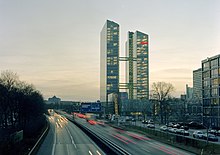
The Highlight Towers

BMW World
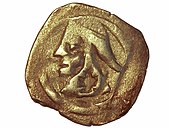
Munich penny with monk's head at the time of Stefan II (1349-1375)

Allianz Arena
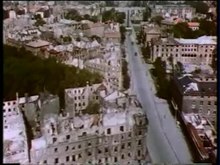
Play media file Flight over destroyed Munich 1945
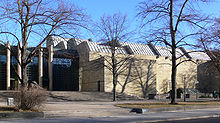
New Pinakothek

Bond for 50,000 Marks of the Bayer. City of Munich, February 15, 1923
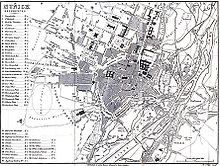
City map of Munich, 1858

Market Square (today Marienplatz) (copperplate engraving by Matthäus Merian, ca. 1650)

Three-dimensional model of the city from 1570, by Jakob Sandtner.
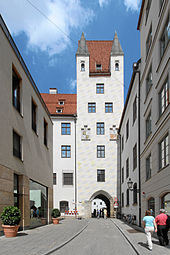
Old farm
Politics and political institutions
Traditionally, the center-left parties dominate local politics in Munich, and to a lesser extent state and federal politics, which is rather rare in Bavaria. The CSU, the Free Voters and the AfD are traditionally weaker on the Isar than in the rest of the Free State, while the SPD, the Greens, the FDP and the Left are stronger. Numerous institutions exercising state power have their headquarters in Munich.
European and federal policy
Munich is the seat of several federal courts and authorities (see below), such as the Federal Fiscal Court, the Federal Patent Court, the Southern Troops Service Court, and the German Patent and Trademark Office.
Munich is also the main location of the European Patent Office.
· 
European Patent Office, main building in Munich
· 
Office building of the German Patent and Trademark Office in Zweibrückenstraße
· 
Fleischerschlösschen, seat of the Federal Finance Court
· 
Headquarters of the Troops Court South
Of the Bundestag constituencies in Bavaria, Munich accounts for four: Munich-East, Munich-North, Munich-South and Munich-West/Center. The only direct mandate in Bavaria won by the SPD was the Munich-North constituency in the 2002 and 2005 Bundestag elections. In 2009, Johannes Singhammer was able to win back the mandate for the CSU. In the 2017 federal election, all four direct mandates in Munich again went to the CSU. In Munich, however, the Greens were then even ahead of all other parties in the 2019 European election.
State capital and state administration
As the state capital, Munich is the seat of the Bavarian Parliament and the Bavarian State Government, as well as many of Bavaria's state authorities (see below). As the central state authority, Munich is also home to the government of Upper Bavaria, which, like Bavaria, is also administered from Munich.
In the Bavarian state elections, Munich is currently represented by nine constituencies.
At the municipal level, Munich is also the seat of the district of Upper Bavaria, the largest district in Bavaria, the local authority established as the third municipal level above the districts (second level) and municipalities (first level). Since the district of Munich is administered from Munich, even though the city itself is district-free, the Landratsamt München is also located here. The Landratsamt serves as both a local self-governing authority and a lower state administrative authority.
·
Maximilianeum, seat of the Bavarian State Parliament
· 
State Chancellery, Seat of the Bavarian State Government
· 
Government building of the government of Upper Bavaria
· 
Landratsamt am Mariahilfplatz, seat of the district administration in Munich
Mayor and City Council
→ Main article: Munich City Council and List of Mayors of Munich
The Lord Mayor of Munich is directly elected every six years and is also the head of the city administration. Since May 2014, Munich has been governed by Lord Mayor Dieter Reiter (SPD), the successor to Christian Ude (SPD), who previously held office for twenty years. Second mayor is Katrin Habenschaden (Green Party), third mayor is Verena Dietl (SPD).
City Council Election 2020
Voter turnout: 49.0
%
30
20
10
0
29,1
24,7
22,0
4,0
3,9
3,5
3,3
2,5
1,0
7,1
Green
CSU
SPD
ÖDP
AfD
FDP
Left
FW
Pink list
Otherwise.
Gains and losses
compared to 2014
%p
14
12
10
8
6
4
2
0
-2
-4
-6
-8
-10
+12,5
−7,9
−8,8
+1,5
+1,4
+0,1
+0,9
−0,2
−0,9
+1,5
Green
CSU
SPD
ÖDP
AfD
FDP
Left
FW
Pink list
Otherwise.
Template:Election Chart/Maintenance/New Result Not 100%
Template:Election chart/maintenance/old result not 100%
The Munich City Council consists of eighty city councilors and the Lord Mayor and is also elected every six years. From 1996 to 2014, the Munich City Council was led by a coalition of the SPD, the Greens and the Rosa Liste; from 2014 to 2020, it was replaced by a grand coalition of the SPD and the CSU. However, in the 2020 Munich municipal elections, the Greens were the strongest party in the city council for the first time, ahead of the CSU and SPD, both of which suffered heavy losses. The new alliance for the city government is consequently called Green-Red. Also involved in the alliance since the end of April 2020 are the Rosa Liste and Volt.
·
Old town hall, today representative building of the city administration
· 
New City Hall, seat of the Munich City Council
· 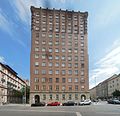
Municipal high-rise building, seat of the Department for Urban Planning and Building Regulations
· 
Technical City Hall, seat of the technical departments of the Munich City Administration
Municipality
The Munich City Administration is the municipal self-government of the city of Munich. It is the largest city administration in Germany (in Berlin and Hamburg, as city states, state and municipal activities are not separated). It is divided into several units.
District representation
Munich's municipal districts represent an administrative division of the urban area of the Bavarian state capital Munich. The citizens of the city district determine their honorary representatives for the respective district committee by direct election.
Sovereign symbols
→ Main article: Coat of arms of the state capital Munich
According to a city council resolution of November 27, 2002, the state capital of Munich has a small and a large city coat of arms.
For official purposes, only the small city coat of arms is used. It essentially corresponds to the city coat of arms established by the City Council in 1957.
|
| Blasing: "On silver shield ground monk with black robe edged in gold, oath book and shoes red, face and hands flesh colored." |
This is a speaking coat of arms, since the monk shown in the coat of arms refers to Munich by name. The monk was already depicted on the first known city seal of Munich, initially in 1268 as a head with hood, and from 1304 as a full figure. In the course of time, the monk in the coat of arms developed into the Münchner Kindl.
The so-called large coat of arms is no longer used in official dealings, but serves exclusively representative purposes.
|
| Blazon: "In silver an open red city gate between two red tin towers with roofs banded by black and gold in multiple zigzags; above a growing golden crowned and armed golden lion; in the gate the monk of the small coat of arms." |
The Munich city colors have been the colors of the Old Empire since the time of Emperor Ludwig the Bavarian: black and gold. The Munich city flag shows these two colors striped lengthwise. In analogy to the state flag of Bavaria, a rough version is also used. Occasionally, the small city coat of arms is depicted in the center of the flag.
· .svg.png)
Hoist flag
· .svg.png)
Hoist flag with diamonds
· 
Banner flag
· 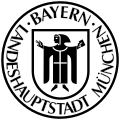
Official seal
Town twinning
![]()
| Edinburgh |
![]()
| Verona |
![]()
| Bordeaux |
![]()
| Sapporo |
![]()
| Cincinnati |
![]()
| Kiev |
![]()
| Harare |
![]()
| M. |
|
|
| Twin cities |
The following twinning arrangements exist:
- since 1954: United Kingdom
 Edinburgh, United Kingdom
Edinburgh, United Kingdom - since 1960: Italy
 Verona, Italy
Verona, Italy - since 1964: France
 Bordeaux, France
Bordeaux, France - since 1972: Japan
 Sapporo, Japan
Sapporo, Japan - Since 1989: United States
 Cincinnati, United States
Cincinnati, United States - since 1989: Ukraine
 Kiev, Ukraine
Kiev, Ukraine - since 1996: Zimbabwe
 Harare, Zimbabwe
Harare, Zimbabwe
Sponsorships
On August 17, 1952, the sponsorship for the expelled Sudeten Germans from the town and district of Ústí nad Labem was taken over.
To support reconstruction in the former Yugoslavia, Munich sponsored the Bosnian municipality of Vogošća in 1999 and the Serbian municipality of Subotica in 2000.
Organic City Munich
Munich is one of the founding members of the Biostadt network in Germany. As early as 2006, Munich began the Biostadt München project, which is anchored in the Department of Health and Environment. Within this framework, the city of Munich cooperates with various partners from the fields of agriculture, trade, environmental protection and sustainable nutrition.
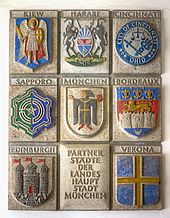
Wall sculpture of Munich's twin cities in the New Town Hall
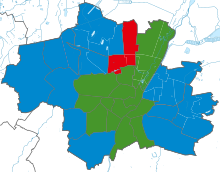
Strongest party in the 2020 municipal election by district: CSU Green SPD
Architecture
→ Main article: Sights in Munich, Bridges in Munich and List of monuments in Munich.
→ Main articles: List of church buildings in Munich, List of palaces in Munich and List of castles in Munich.
see also: Emergence of the Munich cityscape
Marienplatz is considered the center of Munich and is located in the center of the old town, surrounded by the New and Old Town Halls. To the southeast of Marienplatz lies the Angerviertel, to the southwest the Hackenviertel, to the northwest the Kreuzviertel and to the northeast the Graggenauer Viertel and further towards the Isar the Lehel (St.-Anna-Vorstadt). Here lies the old Munich, only since the beginning of the 19th century the city expanded rapidly and soon included in the south the Isarvorstadt, in the west the Ludwigsvorstadt and with the construction of the boulevards of the kings also the Maxvorstadt in the north and east beyond the Isar Haidhausen and the Au. Most of the buildings worth seeing are concentrated here in the center of the city. Architecturally significant are also other buildings in the northwest of the old town, i.e. in Schwabing and Nymphenburg. In addition, many old town centers in the city districts have been partially preserved, especially the village churches.
Romanesque and Gothic
A few steps south of Marienplatz is St. Peter's Church, the oldest church in the old town, whose first building dates back to the Romanesque period. Today there is a Gothic new building, which was baroqueized in the interior in the subsequent period. Since the demolition of St. Jacob's Church in 1955, there is no longer a Romanesque building in the city center, but several churches in the former suburbs with a Romanesque core have survived, such as St. Cross in Fröttmaning with its fresco, St. Johann Baptist in Johanneskirchen, St. Martin in Moosach and St. Nikolaus in Englschalking. St. Sylvester in Schwabing, which like many other present-day districts appeared in historical documents long before Munich, also still shows Romanesque components. Also noteworthy is one of the rare Romanesque crucifixes in the Heilig Kreuz church in the Forstenried district.
From the Gothic period, on the other hand, besides St. Peter's Church, many buildings have survived. Many are made of brick, in an area where quarries that could have supplied other building materials were scarce. Also, the Gothic ornamentation, rich elsewhere, is almost completely absent from the exterior facades. In the 14th century, under the reign of Emperor Ludwig the Bavarian, the first great flowering of art began in Munich. From the former city fortifications from this time, when the Second Ring Wall was completed, the Isar Gate in the east, the Karl Gate in the west at the Stachus and the Sendlinger Gate in the south as well as the Lion Tower at the Rindermarkt. The most important secular buildings in the Graggenau quarter are the Alte Hof, the first residence of the Wittelsbach dynasty, and the Zerwirkgewölbe. After the city fire of Munich in 1327, St. Peter's Church was also rebuilt. A Gothic hall church is the Heiliggeistkirche at Viktualienmarkt, which was remodeled in the Baroque period. The former Augustinian Church on Kaufingerstrasse between Marienplatz and Stachus now serves as the German Hunting and Fishing Museum, while the Lorenz Chapel of the Old Court and the Franciscan Church no longer exist.
However, the high point of Gothic architecture in Munich is represented by the works of the 15th century from the late Gothic period. Jörg von Halsbach was the leading master builder. The Old Town Hall with its dance hall was built at that time, as well as the Armory in the Angerviertel, which is now part of the City Museum. The late Gothic Frauenkirche (Church of Our Lady), located near Marienplatz, with its two distinctive towers with characteristic Renaissance hoods, is a landmark of Munich. In 1468, after the demolition of St. Mary's Church, the foundation stone was laid and after only twenty years one of the most monumental brick churches in Europe was essentially completed. It has served as a cathedral since the establishment of the archbishopric. The late Gothic cemetery churches of the Frauenkirche and St. Peter's, the Salvatorkirche in the Kreuzviertel and the Heiligkreuzkirche in the Hackenviertel have also survived to the present day.
Several Gothic churches have also been preserved in the city's districts, although some were also altered in the Baroque period, such as the pilgrimage church of St. Maria Ramersdorf or St. Georg in Bogenhausen. The castle chapel of Blutenburg Castle and the Filialkirche St. Wolfgang in Pipping, on the other hand, have preserved their original Gothic state and are today considered the best testimonies to late Gothic architecture in Munich. Grünwald Castle is the only medieval castle that has survived in the vicinity of Munich. Veste Planegg, on the other hand, was completely rebuilt in the following period.
Renaissance and Mannerism
While the architecture of the late medieval city was still primarily characterized by bourgeois art, with the reunification of Bavaria in 1504 the court increasingly determined the architectural development of the city.
Important Renaissance buildings were erected in the 16th century for the Jesuits in the age of the Counter-Reformation, for example in the Kreuzviertel between Marienplatz and Stachus the Michaelskirche, the largest Renaissance church north of the Alps, and the adjoining Alte Akademie. Shortly before, the oldest remaining parts of the Residenz buildings had been erected for the court, including the inner courtyard of the Alte Münze, the former Marstall. The Antiquarium of the Residenz represents one of the most important preserved collection buildings of this era and is also the largest Renaissance hall north of the Alps. The Grottenhof of the Residenz with the Grottenhalle is a major work of Mannerism in Germany. Of the Maxburg, a Renaissance city palace in the Kreuzviertel, only the tower has survived.
The Weinstadl near the Altes Hof, which was rebuilt in the Renaissance period, survived all times as one of the oldest still existing town houses. The later so-called Eilleshof near the Residenz, built around 1560, is one of the last originally preserved Laubenhöfe in Old Munich. However, the Hofbräuhaus, founded in 1589, is now located in a 19th century neo-Renaissance building at Platzl.
The Old Schleißheim Palace in the north and Laufzorn Palace in the south of the city, which were Wittelsbach residences built in the late Renaissance at the beginning of the 17th century, are both influenced by Italian villa buildings of the period.
Baroque and Rococo
At the beginning of the 17th century, in the period of transition to the Baroque, the residence was generously expanded by the construction of the so-called Maximilian Residence. In 1638, the Marian Column was erected on the Marienplatz. The earliest baroque church still standing in the city center is the now secularized Carmelite Church in the Kreuzviertel, which, like St. Stephan's in the Isarvorstadt, was still built in the tradition of local builders. With the mighty domed building of the Theatinerkirche (St. Cajetan) on Odeonsplatz opposite the Residenz, the Italian Baroque then moved into Munich in 1663, which with its main representatives Enrico Zuccalli and Giovanni Antonio Viscardi became dominant for several decades until the French-trained architects Joseph Effner and François de Cuvilliés became court architects.
Numerous other churches from the Baroque period can be found in the city, such as the Bürgersaal Church and the Holy Trinity Church in the Kreuzviertel and the Damenstiftskirche in the Hackenviertel, as well as several aristocratic palaces near the Residenz, in particular the Palais Porcia, the Old and New Preysing Palais and the Palais Holnstein, the current residence of the Catholic archbishop. For the Residenz, Cuvilliés created the elegant exterior facade of the Grüne Galerie. Examples of the few remaining town houses from this period are the Haus zur Hundskugel in the Hackenviertel and the Gunetzrhainerhaus on Promenadeplatz, which was reconstructed after World War II. Near the Sendlinger Tor is the Asamkirche, whose interior was designed in splendid late Baroque, with the Asamhaus. The Asam-Schlössl was the residence of the baroque artist Cosmas Damian Asam in the Munich district of Thalkirchen. Work had already begun on the baroque redesign of the local church of St. Maria in Thalkirchen.
The main works of the southern German Baroque are Nymphenburg Palace with its park castles in the west of the city, Lustheim Garden Palace and the monumental New Schleißheim Palace in the north. Much smaller are the Suresnes Palace in Schwabing and Fürstenried Palace in the southwest of the city, which were built at the same time.
The monastery church of St. Anna in Lehel was Bavaria's first rococo church, built from 1727. The most important rococo church outside the city center is St. Michael in Berg am Laim, also by Johann Michael Fischer. Showpieces of the courtly rococo are especially the Amalienburg in the Nymphenburg Palace Park and the Cuvilliés Theater in the Residenz. Due to the tight budgetary situation, no more major buildings were erected for the court from the middle of the 18th century onwards, and church construction also declined noticeably in the Age of Enlightenment. Of the aristocratic palaces of the late rococo period, only the Palais Gise and the Palais Seinsheim in the Kreuzviertel have survived in part. Shortly thereafter, the New Landscape Building in the Angerviertel and the war-damaged Elisabeth Church in the Ludwigsvorstadt were built for the estates; they already show the transitional style from late Rococo to Classicism. After that, only a few sober functional buildings were erected, such as that of the Electoral Gallery at the Hofgarten.
Classicism, Historicism and Art Nouveau
When the Kingdom of Bavaria was founded and the population grew by leaps and bounds, a flurry of construction activity began again at the beginning of the 19th century. The National Theater by Karl von Fischer on Max-Joseph-Platz in front of the Residenz was built in 1811, a major work of classicism. The four major boulevards laid out by the Bavarian kings also lead from the Residenz to the city districts. King Ludwig I in particular intervened in the planning as Crown Prince. Through his architects Leo von Klenze and Friedrich von Gärtner, he had numerous magnificent neoclassical buildings erected.
To the west in the direction of Nymphenburg, Brienner Strasse, marked by the destruction of the Second World War, leads through Maxvorstadt, interrupted by the star-shaped Karolinenplatz with its obelisk and Königsplatz with the magnificent Doric gate of the Propylaea and the Ionic Glyptothek. Behind the Corinthian building of the Antiquities Collections is the Benedictine Abbey of St. Boniface. Among others, the Palais Almeida and other palaces on Wittelsbacherplatz have survived from the early classicist buildings. A little north of the street, the two buildings of the Pinakothek museums were built a short time later according to designs by Klenze and Gärtner.
Towards the north in the direction of Schwabing, Ludwigstrasse was laid out between the Feldherrnhalle and the Siegestor. At Odeonsplatz in the southern section of the street, the Odeon and the Palais Leuchtenberg were built. In the northern part of the street are located, among others, the Bavarian State Library, the Ludwig Church and the Ludwig Maximilian University. At about the same time, the Bavaria was built on the Theresienwiese in front of the Doric Hall of Fame. The Residenz developed into one of the largest city palaces through the extensions designed by Klenze with the Florentine Königsbau, the Festsaalbau and the Allerheiligen-Hofkirche.
South of the Residenz, in front of the Opera, begins Maximilianstrasse, which was designed as a parade street in the mid-19th century. It leads from the Old Town eastward across the Isar toward the Maximilianeum, the seat of the Bavarian Parliament. It is also the site of the Munich Schauspielhaus, later redesigned in Art Nouveau style, the building of the government of Upper Bavaria and the Museum Fünf Kontinente. Today, Maximilianstrasse is a luxurious shopping mile.
Finally, starting from the north side of the Residenz, the Prinzregentenstrasse, leading east from the early classical Prinz-Carl-Palais at the Hofgarten, was created, along which the National Museum and the Schackgalerie are located. Where the street reaches the level of the river terrace on the orographically right bank of the Isar in Haidhausen stands the Friedensengel. The Haidhausen part of the street is also home to the Villa Stuck and the Prinzregenten Theater.
Of the glass and iron constructions, which were considered technical masterpieces at the time they were built in the mid-19th century, the Schrannenhalle on Viktualienmarkt has partially survived, while the Glaspalast burned down in 1931; only the ornamental fountain has survived and is now located in the center of Weißenburger Platz in the Haidhausen district.
Towards the end of the 19th century Many magnificent buildings of historicism were erected in the late 19th century, such as the State Theater on Gärtnerplatz in Isarvorstadt, the neo-Gothic New City Hall on Marienplatz by Georg von Hauberrisser, the neo-Baroque Palace of Justice on Stachus and the neighboring New Justice Building, both by Friedrich von Thiersch, as well as the Army Museum on Hofgarten (today the Bavarian State Chancellery is located here) and the neo-Renaissance Academy of Fine Arts on Akademiestraße near the Siegestor.
Starting with the Mariahilfkirche in the Au, three large neo-Gothic churches were built near the eastern bank of the Isar, St. Johann Baptist in Haidhausen and the Heilig-Kreuz-Kirche in Giesing, which was later joined by St. Paul an der Theresienwiese as a fourth mighty neo-Gothic building. After the Frauenkirche, these churches, along with St. Peter's, have the tallest steeples in the city; they are all more than ninety meters high. On the western bank of the Isar, on the other hand, Romanesque-inspired churches dominate the cityscape, St. Lukas and the parish church of St. Anna in Lehel, as well as St. Maximilian and St. Anton in Isarvorstadt and, further west, St. Benno in Maxvorstadt. The two large neo-Baroque churches of St. Joseph in Maxvorstadt and St. Margaret in Sendling, as well as St. Ursula in Schwabing, the only large church of Historicism in Munich that was influenced by the Renaissance, also had an impact on the city. With the Church of the Redeemer in Schwabing, local architecture was then used without imitating a particular style and elements of Art Nouveau were incorporated.
In Schwabing in particular, there are still numerous residential buildings built in the Art Nouveau style. Not far from the Deutsches Museum, which was built in 1909, and the Gasteig, Munich's oldest public indoor swimming pool is located in the Au, the Müllerschen Volksbad, which was opened in 1901 after a four-year construction period and was built in the Art Nouveau style. Pasing, which like Schwabing was last a city in its own right, also still has many 19th-century buildings.
There are about 1,200 fountains in Munich, of which about 700 are municipal. Prominent fountains include the Wittelsbach Fountain on Lenbachplatz and the Father Rhine Fountain on Museum Island, both works by Adolf von Hildebrand.
Modernity and postmodernity
Munich's architecture since the beginning of the 20th century was strongly influenced by urban planners and architects such as Theodor Fischer, Carl Hocheder, German Bestelmeyer and Otho Orlando Kurz, who constructed numerous buildings in the city. The Borstei is a listed housing estate in the Moosach district, built between 1924 and 1929. From 1928, the Neuhausen housing estate was built. The Postbauschule was an important manifestation of Neues Bauen between 1920 and 1934. Robert Poeverlein and, above all, Robert Vorhoelzer are considered to be the initiators of this school, with the eponymous Munich post office buildings at Tegernseer Platz, Harras and Goetheplatz, as well as the Postpalast.
Among the buildings from the National Socialist era that have survived are the Haus der Kunst and the former Luftgaukommando on Prinzregentenstrasse, as well as the party buildings on the eastern edge of Königsplatz. On the other hand, important buildings such as the Matthäuskirche, the main synagogue and the Herzog-Max-Palais were demolished during this period or, like the Atelier Elvira, were demolished.
During World War II, the majority of Munich's buildings were heavily damaged or even destroyed in 66 air raids. Only 2.5% of the buildings remained intact and almost half of the building mass was destroyed. The train station area, the old town and Schwabing were particularly hard hit. Many historic buildings that now characterize Munich's cityscape were rebuilt after the war, reconstructed according to old plans, or partially rebuilt in the style of the old town. What was lost, however, were some architecturally very significant buildings such as the Palais Piosasque de Non, historically important buildings such as the Wittelsbacher Palais, as well as structures that had once helped define the city's silhouette, such as the large domed building of the Ministry of Transport. The old town ring, which was only broken through the city center after the war, also influences the appearance of all four royal boulevards today.
In the decades after the Second World War, significant examples of modern architecture were occasionally built, some of which were demolished again, such as the spectacular Landesversorgungsamt by the Luckhardt brothers in 1989. The futuristic Schwabylon even existed for only six years until 1979. Among the more important works of the 1950s are the Kaufhof am Stachus by Theo Pabst, the first new Munich department store to be built after the end of the war, the Neue Maxburg justice building on Lenbachplatz, which he built together with Sep Ruf, and the new St. Matthew's Church by Gustav Gsaenger. Significant examples of modern architecture in Munich are also the sports facilities (see below), especially in the Olympic Park. Starting in 1965, the huge Paketposthalle (parcel post hall) was built, which is now a listed building. The large cultural buildings of the 1970s and 1980s, such as the new building of the Neue Pinakothek or that of the cultural center at the Gasteig, are still the subject of very controversial discussions today; reconstruction is planned for both. Since the 1990s, however, the city has been experiencing a second Gründerzeit, which has produced increasingly sophisticated architecture. The Sacred Heart Church is considered the most successful sacred building.
With the exception of the Old Technical City Hall from the 1920s and the Central Tower Munich, the relatively few high-rise buildings in Munich are located outside the city center. Also, in 2004, a referendum limited the height of future high-rises to 100 meters. Most noteworthy architecturally are the BMW Four Cylinder at Olympiapark, next to which the futuristic BMW Welt opened in October 2007, as well as the Hypo-Haus in Arabellapark and the Highlight Towers located in the north of Schwabing. The city's tallest skyscraper, at 146 meters, is Uptown Munich. The tallest building in the city is the 291-meter-high Olympic Tower (see below).
On November 9, 2006, the new Jewish Center at St.-Jakobs-Platz in the city center was opened - an ensemble consisting of the new main synagogue Ohel Jakob, the community center of the Jewish Community Munich and the municipal Jewish Museum (opened on March 22, 2007). It is the largest Jewish center in Europe. The ensemble was designed by the architects Wandel, Hoefer and Lorch, who had also rebuilt the Dresden synagogue. The most striking feature of the ensemble is the differently worked exterior walls of light-colored travertine stone, which, especially on the main synagogue, are intended to be reminiscent of the Wailing Wall in Jerusalem.
Much attention was paid to the construction of the Brandhorst Museum, which was built in Munich's Kunstareal according to plans by the architectural firm Sauerbruch Hutton and opened in 2009. It is located in the immediate vicinity of the Pinakothek der Moderne, which was designed by architect Stephan Braunfels and opened its doors in 2002.
City models
- Jakob Sandtner, plastic model of the city on a scale of 1:616, c. 1570, located at the Bavarian National Museum, a copy on a double scale is in the City Museum
- Johann Baptist Seitz, Anselm Sickinger and others: Plastic city model, ca. 1850, pear tree, scale 1:700, location Bavarian National Museum: Relief of the Capital and Residence City of Munich.
- Anton Hoermann, Friedrich Hoermann: 1915 (scale 1:700)
- German Hochbildgesellschaft 1930 (scale 1:2000)
- 1938/39 (scale 1:1000)
- since the 1970s and continuously continued (scale 1:500), Department of Urban Planning, location Munich City Museum

Amalienburg
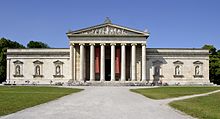
Glyptothek

Theatinerkirche at Odeonsplatz

180-degree panorama from the Frauenkirche looking southeast
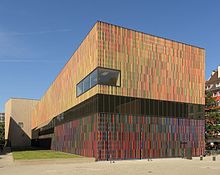
Brandhorst Museum
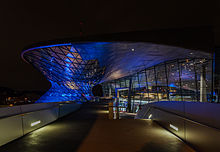
BMW World

Hypo Tower
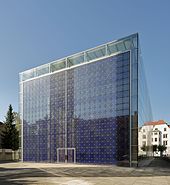
Sacred Heart Church
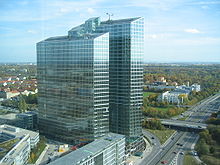
Highlight Towers
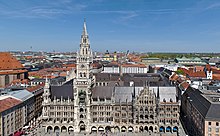
New city hall
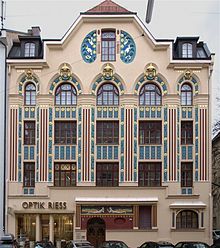
Apartment building Ainmillerstraße 22 with art nouveau facade in Schwabing
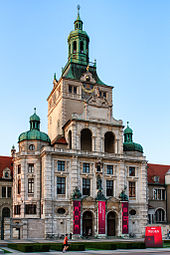
Bavarian National Museum
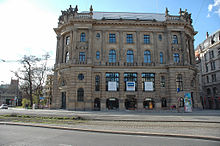
Old stock exchange
.jpg)
Old coin

Old city hall
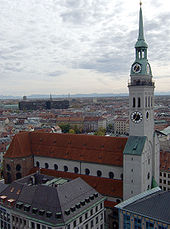
St. Peter
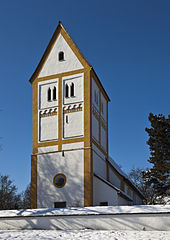
Holy Cross Church in Fröttmaning

St. Michael's Church with the Old Academy
Green spaces
See also: Green spaces in Munich
Parks and zoos
The oldest garden complex is the Court Garden from the Renaissance period with the Diana Temple. During the Renaissance, however, there were hundreds of small gardens in the old town. Munich residents even grew vegetables in them and kept livestock. To the northeast of the Hofgarten are the Finanzgarten and the English Garden, which has been designed since 1789 and runs through Munich from the center to the northern city limits. With an area of 4.17 square kilometers, it surpasses Central Park in New York. The Rumford House and the Chinese Tower have been located here since the time of its creation, and the Monopteros was added later. On the opposite side of the Isar River are the Maximiliansanlagen. In the west of the old town at the Stachus is the Old Botanical Garden, where the Glass Palace stood until it was destroyed by fire. The classicist entrance gate by Herigoyen with an inscription specially written by Johann Wolfgang Goethe has been preserved.
The Nymphenburg Palace Park was created to the west of Nymphenburg Palace in the French style. In the 19th century it was transformed into an English landscape park except for the "Grand Parterre". The New Botanical Garden adjoins to the north. To the southeast of Nymphenburg is the former electoral Hirschgarten. No less than three baroque palaces can be found on the northern city border in the park of Schleißheim Palace. Along with Herrenhausen and Schwetzingen, it is the only surviving large baroque garden in Germany.
Also significant is the Olympic Park, which, in addition to several lakes, also offers an excellent view of the city from the Olympic Hill. The Sea Life Munich aquarium is also located here. In addition, there are numerous other parks and green spaces, such as the Bavariapark, the Luitpoldpark with the Bamberger Haus, the Westpark with the East Asia Ensemble, where the first Federal Horticultural Show - simultaneously as the International Horticultural Exhibition - was held in Bavaria in 1983, and the Ostpark. For the Federal Horticultural Show 2005, Riemer Park, another extensive park in the east of Munich, was created in the Messestadt Riem district. In winter, cross-country skiing is made possible in some parks by specially groomed trails.
The Isarauen are a long, narrow park landscape along the mountain river, which was partially renaturalized on the occasion of the Federal Garden Show 2005. The city can be walked or cycled along the Isar without interruption on various green routes. The actual Isar meadows between the Deutsches Museum and the Isar Island Flaucher are popular places for barbecuing, swimming and moderate free-body culture. South of the Flaucher is the Hellabrunn Zoo.
The parks mentioned above give Munich, which is densely built up overall, a share of public green spaces and recreational areas in the city area of around 11.7 percent. The share of all green spaces in the city area is 49.9 percent, ranking only 74th among the 79 major German cities. In fact, Munich is the city in Germany with the highest proportion of sealed surfaces; around 47 percent of the urban area is built on, concreted over or asphalted.
Cemeteries
Green spaces of a special kind are the abandoned Old Southern Cemetery with numerous celebrity graves near Sendlinger Tor and the likewise abandoned Old Northern Cemetery in Maxvorstadt. The city's green lungs are also Munich's existing cemeteries, with the West, North and East Cemeteries each having magnificent funeral halls designed by Hans Grässel. Munich's largest cemetery is the Waldfriedhof. A cemetery with graves of many celebrities is also the Bogenhausen cemetery. Among other famous people, the Scholl siblings are buried in the Perlacher Forst cemetery.
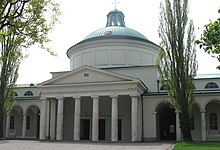
East Cemetery

Nymphenburg Palace Park
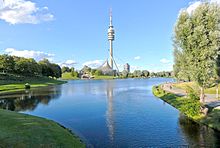
Olympic Park
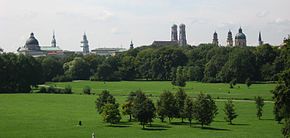
English Garden, view from Monopteros Temple f. l. t. r.: Bavarian State Chancellery, Alter Peter, New City Hall, Residence, Frauenkirche, Theatinerkirche, St. Salvator
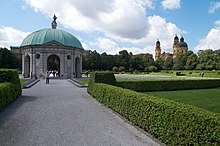
Court garden with Diana temple
Culture
Museums
See also: List of museums in Munich
Art museums and galleries
Munich is internationally known for its collections of ancient and classical art, which are presented in state, municipal and private museums such as galleries.
For example, the Alte Pinakothek and Neue Pinakothek, as well as the Pinakothek der Moderne and the Lenbachhaus, which was greatly expanded in 2014, are among the world's most important galleries. Together with the Glyptothek, the State Collections of Classical Antiquities and the Brandhorst Museum, these collections form the Munich Art Area. The State Museum of Egyptian Art also received a new building in the Kunstareal. The Munich State Collection of Prints and Drawings is also located there on Katharina-von-Bora-Strasse.
Another museum landscape next to the Kunstareal is the Lehel with the Haus der Kunst, the Bavarian National Museum, the Archaeological State Collection, the Schack Gallery, the Gallery of Artists and the Museum Fünf Kontinente, the former Ethnological Museum. Further east of the Isar on Prinzregentenstrasse is the unique Art Nouveau building Villa Stuck with a permanent collection of Franz von Stuck's works as well as top-class temporary exhibitions.
The city center is also home to numerous art museums. The Munich City Museum is located in the former armory on Sankt-Jakobs-Platz and houses a number of different collections and museums: the Sculpture and Applied Art Collection, the Munich Film Museum, the Photography Museum, the Graphic Arts, Poster, and Painting Collection, the Fashion and Textile Collection, the Music Collection (Musical Instrument Collection), the Puppet Theater and Showmanship Collection, and the Urban Culture and Folklore Collections. From the holdings of the various collections, exhibitions are regularly curated that are either collection-specific (for example, in the Museum of Photography) or cross-collection (for example, the exhibition "Typically Munich"). In addition, the city of Munich maintains various galleries such as the Lothringer13, the Kunstarkaden, the Rathausgalerie, the MaximiliansForum or the Artothek, where works of art can be borrowed. The Museum of Urban and Contemporary Art is located in the Hackenviertel district of the city center. The Kunsthalle der Hypo-Kulturstiftung is located on Theatinerstraße. The Residenzmuseum (mainly with the Treasury of the Residenz) is located in the former residence of the Wittelsbach dynasty in Munich's old town and is one of the most important palace museums in Europe. Festival halls, state rooms or court chapels of Bavarian rulers provide an insight into historical room ensembles of different eras with important exhibits of the Wittelsbach collections of silver, porcelain, miniatures, paintings, antique sculptures, bronze sculptures, tapestries, furniture, clocks, candlesticks and chandeliers. The State Coin Collection is also housed in the Residence.
Oberföhring is home to the Goetz Collection, which also presents temporary exhibitions in a museum building designed by Herzog & de Meuron.
In addition to the showrooms, Nymphenburg Palace houses the Marstall Museum and the Nymphenburg Porcelain Collection.
Natural History Museums
Schloss Nymphenburg is also home to the natural history museum Mensch und Natur (Man and Nature). In addition, there are other museums in the city for the state's natural science collections, which have not yet been combined, such as the Palaeontological Museum, the Museum Reich der Kristalle, as well as the Anthropological State Collection, the Geological Museum Munich, the Botanical State Collection and the Zoological State Collection Munich. A crowd puller, also due to its prominent location in the city center, is the German Hunting and Fishing Museum, which also covers aspects of cultural history.
Cultural museums and memorials
In addition to their art-historical collections, the National Museum and the City Museum also have exhibitions on cultural history. Opposite the Munich City Museum is another municipal museum: the Jewish Museum, which forms the new Jewish Center there with the new synagogue and the Jewish Community Center. The Nazi Documentation Center on Brienner Strasse serves as a place to explore the history and consequences of the Nazi regime. In addition, there are several memorials for victims of National Socialism in the city. The Olympic assassination memorial is located in the Olympic Village.
The Altes Hof houses the Infopoint Museums and Palaces in Bavaria and the Munich Imperial Castle exhibition. The smallest museum in the city is the Karl Valentin Museum in one of the two towers of the former city fortifications at the Isartor; it features exhibits on the life and work of the artist Karl Valentine. Not much larger is the Toy Museum in the Old Town Hall Tower. Not far away are the Beer and Oktoberfest Museum and the Munich Fire Brigade Museum. The German Theater Museum is located at the Hofgarten. Since 1998, Schloss Blutenburg has housed a literary museum on the life and work of Michael Ende, part of whose estate is held by the library there. The Alpine Museum on the Prater Island of the Isar River is a museum of the German Alpine Association on the history of alpinism.
Technology museums
The Deutsches Museum on Museum Island on the Isar River, with its globally unique technical exhibits, is one of the most visited museums in Europe, with over one million visitors per year, and is the largest technical and natural science museum in the world. Branches are the Flugwerft Schleißheim and the newly opened Transport Museum at Theresienwiese.
The MVG Museum also exists as a municipal transport museum. In addition, the BMW Museum, the BMW Group Classic and the Museum in the SiemensForum Munich have collections on the history of Munich-based technology companies.
Visual arts
· 
Holy water angel inside St. Michael's Church by Hubert Gerhard, 1595
· 
Wittelsbach Fountain of the Munich Residence by Hubert Gerhard, 1611
· 
Guardian angel in the civic hall, Ignaz Günther, 1763
· 
Count Palatine Ottheinrich, Barthel Beham, 1535
· .jpg)
The poor poet, Carl Spitzweg, 1839
· 
Poster for the VII. International Art Exhibition Munich, by Franz von Stuck 1897
In the late Gothic period in Munich there was a first cultural flowering, when, among others, Erasmus Grasser and Jan Polack worked in the city. In the Renaissance period the city became a center of sculptors, influenced by Hubert Gerhard and Hans Krumpper. As painters, Barthel Beham, Hans von Aachen and Peter Candid were active in Munich during this period. In the 18th century, the city experienced a Golden Age of fine arts, dominated by personalities such as Cosmas Damian Asam, Egid Quirin Asam, Johann Michael Fischer, François de Cuvilliés, Ignaz Günther, Johann Baptist Zimmermann and Johann Baptist Straub.
In the 19th century there was a second flowering of the ore foundry when Johann Baptist Stiglmaier and Ferdinand von Miller worked in the town.
From about 1850 to 1914, Munich developed into one of the centers of European painting. The Munich School emerged in the environment of the Royal Academy of Fine Arts. To this day, this school has great significance in art history as a representative of academic painting. Well-known teachers at the Academy included Karl von Piloty, Wilhelm von Diez, Arthur von Ramberg and Nikolaus Gysis. The Munich Secession, with members such as Max Liebermann, Franz von Stuck, Lovis Corinth, Ernst Oppler and Walter Leistikow, emerged from the Academy's environment (and as a spin-off of the Munich Artists' Cooperative).
The Blaue Reiter was founded in 1911 and eventually allowed Munich to become a center of modern art. Its members were Paul Klee, Wassily Kandinsky, Alexej von Jawlensky, Gabriele Münter, Franz Marc, August Macke and Alfred Kubin.
In 1919, Bavaria Film's first studios were built in Geiselgasteig - a district of the municipality of Grünwald in the south of Munich.
Literary life
In the 14th century, Heinrich von München wrote his Weltchronik. In the 15th century, Hans Schiltberger and Ulrich Fuetrer, among others, worked in the city. The city scribe Minervius translated Homer into German for the first time in 1537, and Martinus Balticus also worked in Munich at that time. At the beginning of the 17th century, a circle of poets existed in Munich, to which Jakob Balde and Jeremias Drexel also belonged.
With the Enlightenment, new literary creativity also began in Munich, with Lorenz von Westenrieder as the main representative. Afterwards, a literary circle of Romanticism emerged in Munich around Görres and Schelling.
In the 19th century, among others, Fyodor Tyutchev, Heinrich Heine, Friedrich Hebbel and Hans Christian Andersen lived in Munich for extended periods.
The literary life of the city, with its center in Schwabing, took off in the last decades of the Kingdom of Bavaria and was shaped by writers such as Paul Heyse, Lena Christ, Ludwig Thoma, Thomas Mann, Rainer Maria Rilke and Frank Wedekind.
In the Weimar Republic, the most famous literary Munich representatives were Lion Feuchtwanger, Annette Kolb, Bertolt Brecht and Oskar Maria Graf.
Later, Munich-born writer Eugen Roth achieved literary fame, and many writers such as Erich Kästner, Wolfgang Koeppen and Michael Ende lived and worked in the city.
Theater
See also: List of theaters in Munich and cabarets in Munich
Munich has a very rich theater, ballet and opera culture with five state, three municipal and over fifty private theaters. The most important venues are the Nationaltheater München (Bavarian State Opera, Bavarian State Ballet), the Residenztheater (Bavarian State Theater), the Staatstheater am Gärtnerplatz (opera, operetta, dance and musical), the Prinzregententheater (including the Bavarian Theater Academy August Everding, state theaters, concerts), the Schauspielhaus (Munich Kammerspiele), the Schauburg (also: SchauBurg), the Munich Volkstheater and the Deutsches Theater.
Musical theater, opera and ballet
The musical life of the city has a long tradition. Important composers such as Orlando di Lasso, Carl Maria von Weber, Gustav Mahler, Richard Strauss and Carl Orff worked here. Wolfgang Amadeus Mozart's La finta giardiniera premiered in the Salvatortheater in 1775, followed by the world premiere of his Idomeneo in the Cuvilliés Theater in 1781. Several of Richard Wagner's operas were premiered at the National Theater under Ludwig II. In the musical theater, the Bavarian State Opera and the Staatstheater am Gärtnerplatz are particularly noteworthy, each with its own ballet company: the Bavarian State Ballet and the Ballet of the Staatstheater am Gärtnerplatz. The Munich Biennale, founded by Hans Werner Henze, is dedicated to modern music theater.
Speech Theater
In the field of spoken theater, the city's most important stages are the Bayerisches Staatsschauspiel, the Münchner Kammerspiele and the Münchner Volkstheater. Since Gotthold Ephraim Lessing's premieres in 1775, many well-known authors have premiered their plays in Munich, including Christian Friedrich Hebbel, Henrik Ibsen, Hugo von Hofmannsthal and Ingmar Bergman. The Metropoltheater has won several awards from private theaters, and the Munich Summer Theater, an open-air theater in the English Garden, also attracts thousands of spectators each year. Boulevard theater is offered by the Komödie im Bayerischen Hof - usually with prominent actors in the leading roles.
The Schauburg of the city of Munich plays a central role in children's and youth theater. In addition, there are various other private stages for children, such as the Munich Theater for Children or the Munich Marionette Theater. The puppet theater Kleines Spiel, on the other hand, plays almost exclusively in the evening and for adults.
Cabaret and circus
In the cabaret sector, the Munich Lach- und Schießgesellschaft, the Wirtshaus am Hart, the Theater im Fraunhofer, the Lustspielhaus or the Schlachthof are important stages in the city. Among Munich's cabaret artists, Karl Valentin, Dieter Hildebrandt, Ottfried Fischer and Gerhard Polt stand out.
With Circus Krone, founded in 1905, Europe's largest circus has its permanent winter home in Munich's Kronebau.
Orchestra and choirs
The Munich Philharmonic Orchestra, the Bavarian Radio Symphony Orchestra and the Bavarian State Orchestra are among the most important German orchestras and regularly work with internationally renowned conductors. In addition, the Munich Symphony Orchestra and the Munich Chamber Orchestra enjoy a very good reputation.
Important choirs include the Philharmonic Choir of Munich, the Bavarian Radio Choir, the Munich Bach Choir, the orpheus chor münchen, MünchenKlang or the Tölzer Knabenchor, whose studio is located in Solln and where the majority of the boys come from Munich.
The most important venues for orchestras and choirs in Munich are the Philharmonie im Gasteig (2387 seats), the Prinzregententheater (1081 seats) or the Herkulessaal (1270 seats) in the Munich Residenz. To this day, however, Munich lacks an optimal sounding concert hall, which often led to debates and finally to a rally for the construction of a new concert hall in spring 2015, which was initiated by the student-run choir and orchestra ensemble MünchenKlang. In December 2015, the Free State of Bavaria decided to build the concert hall in the Werksviertel at the Ostbahnhof.
See also: List of Munich Orchestras
Cinema
Munich has several cinemas. The largest cinema in Munich with 14 screens, which is also used for many film premieres, is the Mathäser multiplex cinema located between Stachus and the main train station. In addition to this, there are numerous other cinemas, some of which specialize in screenings in original sound or in individual film genres. The CINEMA movie theater in Maxvorstadt, for example, shows films in the original version and live broadcasts. Open-air cinemas open in summer include Kino, Mond und Sterne in Westpark and Open Air Kino am Olympiasee. Munich's oldest cinema still in operation is the Museum Lichtspiele, which opened in 1910. In 2019, the even older Gabriel Filmtheater, with an opening date of 1907, closed. Also steeped in history are Neues Maxim, which opened in 1912, and Filmtheater Sendlinger Tor, which opened in 1913. In addition to these, there is also the Filmmuseum München, which also screens films. The first IMAX cinema in Germany was the IMAX Munich, which, however, was finally closed in 2010.
Electronic music
Electronic music began with the founding of the Siemens Studio for Electronic Music in the 1950s. Its director was the composer Josef Anton Riedl.
Munich also played a significant role in the development of electronic music when Giorgio Moroder, who invented disco composed on the synthesizer and thus electronic dance music, and disco singer Donna Summer lived and worked in the city and produced world hits such as I Feel Love and Love To Love You Baby here at Moroder's Musicland Studios. In the late 1990s, electroclash was "significantly co-created, if not invented" in Munich, when DJ Hell introduced and assembled international pioneers of the music genre here through his International Deejay Gigolos label.
Cultural and regular events
Nationally known cultural events include the Opera Festival, the Dance Workshop Europe and the Film Festival.
At the beginning of the year, the carnival season is marked by the market women's dance, the carnival hustle and bustle at the Viktualienmarkt and, on Ash Wednesday, the traditional money bag washing at the fish fountain on Marienplatz. In February and March, Ash Wednesday is followed by the "strong beer season", which is celebrated with various events - for example, the Derblecken on the Nockherberg, which is broadcast annually by Bayerischer Rundfunk.
In March, in addition to Saint Patrick's Day, visitors are attracted by the Münchner Bücherschau junior, a major event that focuses on reading promotion alongside children's and young people's literature. At Easter time, an Easter march is held in Munich on Holy Saturday. In April, the Spring Festival is held on the Theresienwiese - a public festival that is smaller than the famous Oktoberfest.
On the first of May, the culture and family festival takes place at Marienplatz. This is followed on the first weekend in May by the start of the first nine-day Auer Dult (Maidult) of the year in the Au district of Munich. Since 1988, an international festival for new music theater has been held every two years: the Munich Biennale. Between May and August, the Munich Bladenight takes place, Europe's largest night-skating event. In May and September, the Corso Leopold takes place.
At the beginning of June, Germany's largest student-organized music and theater festival, the StuStaCulum, takes place in Munich's Freimann district. In mid-June, Munich's city birthday is celebrated every year over a weekend between Marienplatz and Odeonsplatz. In addition, various festivals take place in June: the Streetlife Festival, the Munich Comic Festival, the Munich International Short Film Festival, and at the end of June/beginning of July the Munich Film Festival, the second largest film festival in Germany.
In June and July, the Tollwood Festival takes place at the Olympiapark Süd, the Munich Opera Festival and the Munich Bike Night.
Important events in July are Christopher Street Day, the traditional Kocherlball, the Munich Midsummer Night's Dream, the Impark Summer Festival, the Theatron Festival, the Munich Summer Theater, the Japanfest Munich on the third Sunday at the Japanese Tea House behind the Haus der Kunst. At the end of July, the second Auer Dult (Jakobidult) and Bell'Arte - Musical Summer in the Brunnenhof of the Munich Residenz attract visitors.
During the first ten days of August, Tanzwerkstatt Europa, a festival for international contemporary dance, takes place at various venues in Munich. The Olympiapark also hosts the Summer Festival and the Lilalu & Culture and Family Festival in August. Mini-Munich, a business game for children, takes place every two years.
The second Streetlife Festival and the Munich Outdoor Sports Festival take place in mid-September, and the Oktoberfest begins at the Theresienwiese (the Wiesn), which lasts until the first Sunday in October.
The third, nine-day Auer Dult (Kirchweihdult) begins in mid-October, and in November the Munich Book Fair is held in the Gasteig. In November and December, the Spielart theater festival takes place every two years. Shortly before the first Sunday in Advent, the Winter Tollwood begins on the Theresienwiese, which lasts until New Year's Day. In addition, there are Christkindl markets in various squares in Munich during Advent (for example, Marienplatz, Weißenburger Platz).
Cultural history trails and bike routes
Since 2001, places of historical interest in Munich can be explored via the cultural history trails. Signposted bicycle routes are the Outer Radlring and the RadlRing München.
Culinary specialties
The gastronomy in Munich offers numerous specialties of the Bavarian cuisine. The Weißwurst was invented in Munich in 1857 and is probably the most famous culinary specialty of the city. Further are for example the Leberkäs or the Leberkässemmel, the Brezn, the Auszogne (a round lard pastry), the Prinzregententorte and the Munich beer.
Top gastronomy
With Jan Hartwig's gourmet restaurant "Atelier" in the Hotel Bayerischer Hof, Munich has one of ten restaurants nationwide currently awarded three Michelin stars. In addition, there are three restaurants in the Guide Michelin 2019 with two stars each: "Tantris" (Hans Haas), "Alois" (formerly restaurant "Dallmayr", Christoph Kunz) and "EssZimmer" in the BMW World (Bobby Bräuer). In addition, the 2019 Michelin Guide lists seven Munich restaurants with one star each.
The "Aubergine" restaurant on Maximiliansplatz, which closed in 1994, was the first restaurant in Germany to receive the maximum rating of three Michelin stars under Eckart Witzigmann in the 1980 Guide Michelin. Witzigmann had previously been the first person in Germany to cook one star (Guide Michelin 1974) and two stars (Guide Michelin 1975) in the Munich restaurant "Tantris," which is still open today. Under Heinz Winkler, the "Tantris" became Germany's second three-star restaurant in the 1982 Guide Michelin. This distinction lasted until Winkler's departure in 1991.
Nightlife
Nightlife in Munich nowadays takes place mainly in the city center (Altstadt-Lehel) and the districts of Maxvorstadt, Ludwigsvorstadt-Isarvorstadt, Au-Haidhausen, Berg am Laim, Schwabing and Sendling. Between Sendlinger Tor and Maximiliansplatz is the so-called Feierbanane, an approximately 1.3-kilometer-long unofficial party zone along Sonnenstrasse, which is characterized by a high concentration of clubs, bars and restaurants and became the center of Munich's nightlife in the mid-2000s.
Located in the Ludwigsvorstadt-Isarvorstadt district, Gärtnerplatzviertel and Glockenbachviertel around Müllerstraße are known for numerous popular bars and are considered the center of Munich's gay culture. Maxvorstadt is characterized by many smaller bars that are especially popular with students, while in Schwabing, once known for legendary clubs such as Big Apple, PN hit-house, Domicile, Hot Club, Piper Club, Tiffany, the first German large-scale discotheque Blow Up and the underwater disco Yellow Submarine, as well as pubs such as the Schwabinger 7, nightlife has declined sharply in recent decades due to gentrification.
Opened in 1996, Kunstpark Ost and its successor Kultfabrik, which existed until 2016, a former industrial site near the Ostbahnhof train station in Berg am Laim, were once Europe's largest entertainment district, home to more than 30 clubs and of national importance for nightlife. In the immediate vicinity there were also the Optimolwerke and the Georg-Elser-Hallen. Before that, the site of Munich-Riem Airport, which was abandoned in 1992, had already been home to a collection of internationally renowned halls and clubs.
Overall, Munich's nightlife is changing comparatively quickly due to the high demand for housing and strong gentrification. Nightlife venues that achieved international fame, in addition to the aforementioned scene venues of the 1960s and 1970s, were for example the dance club Größenwahn, the Atomic Cafe, the techno clubs Babalu, Ultraschall, KW - Das Heizkraftwerk, Natraj Temple, MMA Club, Die Registratur and Bob Beaman. From 1995 to 2001, Munich was also home to Union Move, at times the second largest techno parade in Germany, with up to 100,000 participants.
Today, Munich boasts more than 100 nightclubs and thousands of bars and restaurants. Well-known clubs are the techno clubs Blitz Club, Harry Klein, Rote Sonne, Bahnwärter Thiel, Grinsekatze, Pimpernel, Charlie and Palais as well as the clubs 8 Below, Call me Drella, Cord, Wannda Circus, Tonhalle, Willenlos, Backstage, Pacha, Zenith, P1 and the party ship Alte Utting. Some well-known bars are Schumann's Cocktail Bar, Havana Club, Sehnsucht, Bar Centrale, Ksar, Holy Home, Negroni, Die Goldene Bar and Bei Otto.
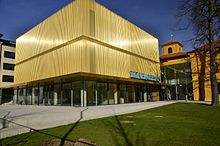
New building of the Städtische Galerie in the Lenbachhaus

Old Pinacoteca

National Theater Munich
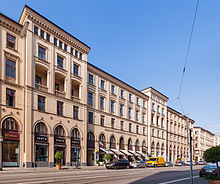
Munich Kammerspiele

Railroad guard Thiel
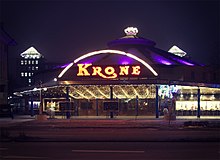
Kronebau
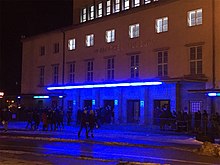
Lightning Club
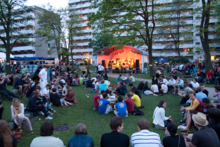
StuStaCulum
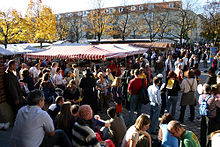
Auer Dult on the Mariahilf Square
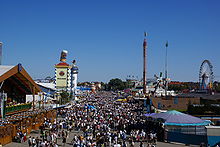
The Oktoberfest
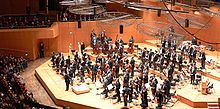
Munich Philharmonic Orchestra at the Gasteig

Nazi Documentation Center Munich
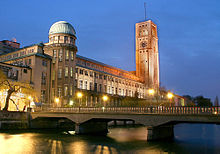
German Museum

Munich City Museum
Economy
Economic performance
According to a comparative study by the magazine Wirtschaftswoche, the lobby organization Initiative Neue Soziale Marktwirtschaft and the company IW Consult, Munich has the second highest economic power among the fifty largest German cities. The latest study by the Initiative Neue Soziale Marktwirtschaft and Wirtschaftswoche magazine once again declared Munich to be Germany's most economically successful city in prognostic terms. The study evaluates economic and structural indicators such as productivity, gross income, investments, innovations, unemployment rate and number of highly qualified people.
In 2016, Munich, within the city limits, produced a gross domestic product (GDP) of 109.571 billion euros, placing it third in the ranking of German cities by economic output. GDP per capita in the same year was 75,186 euros (Bavaria: 44,215 euros, Germany 38,180 euros), well above the regional and national average. In 2016, the city's economic output recorded nominal growth of 3.9 percent. There were approximately 1,087,300 employed persons in the city in 2017. The unemployment rate was 3.4 percent in December 2018, above the Bavarian average of 2.7 percent but below the national average. Munich is the center of the Munich metropolitan region, which generates a GDP of approximately 283 billion euros.
In the 2016 Future Atlas, the independent city of Munich took second place out of 402 districts and independent cities in Germany, making it one of the places with "top future opportunities". First place was taken by the neighboring district of Munich.
Debt
Sovereign Budget
As of December 31, 2019, the debt level of the City of Munich was around 636 million euros, the lowest level since 1982. Since 2006, the City of Munich has been able to finance all investment measures without net new borrowing. By contrast, since the debt peak of 3.414 billion euros in 2005, the city had repaid more than 2.7 billion euros in loans in the sovereign budget by the end of 2019.
This results in a per capita debt of around 408 euros. Compared with the debt peak of 3.414 billion euros at the end of 2005, this is a reduction of around 81 percent. No net new debt is planned for 2020.
Own operations
The municipal corporations of the City of Munich are special funds with special accounts and without their own legal capacity. The debts of the municipal corporations are therefore debts of the state capital.
The City of Munich has several municipal enterprises with debts totaling around 1.3 billion euros.
| Liabilities of the Own Plant Operations of the City of Munich as of December 31, 2017 | |
| Operation | Debt in |
| Waste Management Company Munich (AWM) | 75.800.000 |
| Munich market halls | 22.000.000 |
| Munich Municipal Drainage | 1.038.500.000 |
| Munich Kammerspiele | 59.400.000 |
| Service provider for information and telecommunications technology for the city of Munich | 100.100.000 |
| Total (5) | 1.295.800.000 |
AWM and Münchner Stadtentwässerung are owner-operated companies that refinance their debts entirely through revenues in the form of fees. This means that they do not burden the sovereign budget. This is of particular importance because Münchner Stadtentwässerung has more than 50 percent of the total debt of the City of Munich of around two billion euros. Own companies without debt are, for example, Stadtwerke München and Gemeinnützige Wohnungsfürsorge AG (GEWOFAG).
Fairs and congresses
Alongside Hanover, Frankfurt, Cologne and Düsseldorf, Munich is home to the trade fairs with the largest hall exhibition capacities in Germany. Munich is an important trade fair location, especially with the New Munich Trade Fair Centre operated by Messe München. Since 2011, Messe München has been operating jointly with the ICM and the MOC Veranstaltungscenter München as Messe München Locations.
More than 500 different event venues provide a setting for congresses, symposia and conferences: From the Olympic Stadium to brewery festival halls, this also includes the numerous congress hotels, plus rooms that can be rented, for example, in the Residenz, in Nymphenburg Palace or in the Deutsches Museum. Other important venues are the Alte Kongresshalle and the Reithalle.
Tourism
The sights and shopping opportunities in the city, as well as its trade fairs and congresses, attract numerous tourists and business travelers. In 2008, the expert jury of the National Geographic Traveler ranked Munich 30th in the worldwide ranking of the best 110 historical places.
The number of overnight stays grew to 9.9 million in 2009 (up 0.6 percent). Of these, 4.4 million traveled from abroad (down 3 percent from 2008). U.S. visitors were the largest foreign travel group with 597,000 overnight stays (down 2.4 percent), followed by Italians (518,000) and Britons (341,000). A special feature of Munich in the summer months are the many Arab tourists from the Gulf region (271,000 overnight stays), who not only shop in the city center but often seek medical care in Munich clinics during their stay. In 2011, 102,000 tourists from the Gulf states vacationed in Munich, according to the tourism office. With nearly 5.25 million foreign visitors, Munich was the 23rd most visited city in the world in 2016 and ranked first in Germany. Tourists brought in revenue of $5.3 billion in the same year. Most foreign visitors came from Europe, Asia and the United States. In 2019, Deutsche Presse-Agentur reported revenues of "just over eight billion euros a year." Ranked eleventh in the world for tourist density relative to population, Munich was the highest-ranked German city in 2019, according to visa application company Official Esta.
The complete elimination of tourism, which generates an annual economic value of 8.3 billion euros in Munich, caused the entire tourism value added for the months of March to May to be eliminated without replacement due to the COVID 19 pandemic. The entire trade fair and congress tourism sector lies fallow due to the events not taking place, at least until Messe München reopens in September 2020. All major events have been canceled for 2020, including the Oktoberfest with lost revenues of 1.23 billion euros.
For the hospitality industry, the loss of sales cannot be narrowed down for Munich due to the statistical data available. The Bavarian figures, which are at least as applicable to Munich, state a drop in sales of -76.4% for April 2020 compared to the same month of the previous year and a drop in employment of -28.4%.
Retail
The retail trade in Munich is versatile. From the inexpensive to the luxury segment, all categories are covered. With Neuhauser Strasse and Kaufingerstrasse, Munich is twice represented among the five most visited shopping streets in Germany. According to a survey by Jones Lang LaSalle, Neuhauser Strasse had the second-highest visitor frequency in Germany, with 13,515 passers-by per hour; only Schildergasse in Cologne was more frequented, with 14,265 passers-by per hour. After the Zeil in Frankfurt am Main (13,035 passers-by), Kaufingerstrasse was in fourth place with 12,975 passers-by per hour. Both shopping streets are in the low to medium price category. Together with Hohenzollernstrasse, Leopoldstrasse forms the "Schwabing T" with rents of up to 105 euros per square meter. Many international retailers, especially from the fashion and jewelry industries, can be found on part of Maximilianstrasse, elevating it to a fashionable shopping street. Larger shopping centers are the Euro-Industriepark, the Olympia-Einkaufszentrum, the pep or the Fünf Höfe.
Retailers in Munich were affected to varying degrees by the COVID 19 pandemic. While stores for daily needs were open during the curfews and recorded sales growth, local retailers, on the other hand, suffered massive sales losses. Food retailers saw a 13.4 percent increase in sales in April 2020, while textiles, clothing and footwear retailers saw a -80.2 percent drop in sales.
Industry
Numerous companies have their headquarters in Munich and the surrounding area. Especially after the Second World War, many companies moved their headquarters from Berlin or East Germany to Munich. Important economic sectors in Munich are tourism, automotive and mechanical engineering, electrical engineering as well as software and IT industry. The high density of IT companies has also earned Munich the nickname "Isar Valley". Munich is also an important financial center and the insurance center of Germany. Furthermore, the city is an important location for biotechnology, which, however, is concentrated in the Martinsried district, which already belongs to the neighboring municipality of Planegg. Logistics companies are located, for example, in the Kirschstraße industrial park in Allach, where the industrial company Krauss-Maffei is also located. One of the best-known newer companies is Flixmobility.
Among cities with Global 500 companies, Munich ranked eighth worldwide in 2009. With Allianz SE, BMW, Munich Reinsurance and Siemens, and since September 2019 MTU Aero Engines and March 2021 Siemens Energy, six of the thirty DAX companies have their headquarters in Munich. This puts the city at the top of this statistic. Other DAX companies are located in suburban communities, Neubiberg is home to Infineon, and despite a company merger in 2018, Linde in Pullach remains in the DAX. MAN's corporate headquarters are also located in Munich-Allach; however, the company has not been included in the DAX since September 2012. Among the medium-sized companies in the MDAX, eleven out of 60 are based in Munich. In a ranking of the most important financial centers worldwide, Munich ranked 35th (as of 2018).

Kaufingerstraße is a well-known shopping street in Munich.
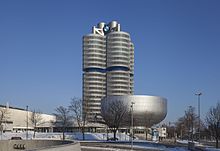
BMW headquarters with BMW four-cylinder and BMW Museum

Siemens Forum in Munich
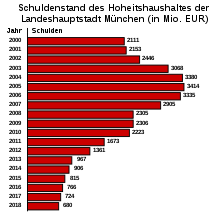
Source: Debt development and forecast of the Munich City Treasury

International Congress Center of the New Munich Trade Fair
Media
As a media location, the city is of nationwide importance. After New York, Munich is home to the world's second-largest number of publishing houses. The television and film industries are strongly represented in the city and the immediate surrounding area (television industry in Unterföhring and film industry in Geiselgasteig, to Grünwald). With Constantin Film, Bavaria Film and other companies, Munich is also one of the leading film cities.
Publishers
With around 250 resident publishing houses, Munich is an important location for print media (for example, Burda Verlag, Süddeutscher Verlag, IDG). Alongside New York City, the state capital has a reputation as the world's leading book publishing city.
Munich is home to the following publishers, among others: Deutscher Taschenbuch Verlag, Langenscheidt Verlag, Bonnier, C. H. Beck Verlag, Carl Hanser Verlag, Droemer Knaur, Elsevier, Gräfe und Unzer Verlag, Oldenbourg Verlag, Piper Verlag, Prestel Verlag, Verlagsgruppe Random House, Verlag Antje Kunstmann.
For the history of the book trade in Munich, see the article Münchner Buchhandel 1500-1850.
Daily newspapers
In addition to the Süddeutsche Zeitung (SZ), which is also important nationwide, the tz, the Münchner Merkur and the Abendzeitung (AZ) should be mentioned. The Bild appears with its own local section on Munich.
Television and radio
Munich is home to Bayerischer Rundfunk, the program management of the ARD joint program Das Erste and the ZDF regional studio in Bavaria. Furthermore, there are numerous private television and radio providers in Munich and the immediate surrounding area, such as RTL II, ProSiebenSat.1 Media (ProSieben, Sat.1, kabel eins), Tele München Gruppe, Sport1, Sky Deutschland, München TV. Two statewide private radio stations are based in Munich: Antenne Bayern and egoFM. There are also five local radio stations: Radio Gong 96.3, Radio Arabella 105.2, Energy München, 95.5 Charivari and Radio2day 89.0.
Media training
The Ludwig Maximilian University of Munich offers various media-related courses of study, such as media informatics or communication science. The German School of Journalism trains journalists for all media in Munich. The Munich University of Applied Sciences for Film and Television trains future filmmakers, many of whom will work for television and radio in the future. In addition, Munich newspaper publishers, TV and radio stations train future media makers in traineeships.

Main broadcasting house of the Bavarian Broadcasting Corporation in Munich
Infrastructure
Supply of radio and television stations
In summer 2005, digital radio reception via antenna (DVB-T) was introduced in the Munich area. The transmitter is mounted on the Olympic Tower, from which some FM stations are also transmitted. In the district of Munich, there is the Ismaning transmitter, which broadcasts Bayerischer Rundfunk with the local window Munich. There is also the telecommunications tower of the Oberpostdirektion München in Blutenburgstrasse, which transmits the EgoFM station, among others. However, its signal only reaches about as far as the city limits due to its low transmission power, depending on the program.
The Wendelstein transmitter, 65 kilometers away on the mountain of the same name, mainly supplies the southern parts of the city. Three exceptions should be mentioned: the Zugspitze transmitter, the Hochries transmitter near Rosenheim and the Isen transmitter near Ebersberg. They also supply Munich with private radio programs.
Since Munich has a favorable geographical location not far from the Alps, several transmitters on peaks of the Bavarian and Austrian mountains can also provide the city with radio programs, e.g. the Grünten transmitter, the Hohenpeißenberg transmitter etc.
Smooth reception of the Austrian Broadcasting Corporation (ORF) is guaranteed via the Gaisberg transmitter near Salzburg, which can be received relatively well throughout the city, as can the Hohe Salve transmitter in Tyrol or the Zugspitze ORF transmitter.
Electricity, water and gas supply
Stadtwerke München GmbH (SWM) is one of Germany's largest municipal service providers and one of Germany's largest energy utilities. The sole shareholder is the City of Munich.
SWM sells electricity to private and business customers under the name "M-Strom". SWM operates twelve hydroelectric power plants in the Munich metropolitan area and the Munich region, several plants that generate electricity from renewable energy and the three combined heat and power plants South, North and Freimann, which generate around 70 percent of the electricity using cogeneration. SWM and its associated companies also hold a 25 percent stake in the Isar 2 nuclear power plant.
As part of the European interconnected grid, SWM supplies its customers with natural gas. The company has its own underground storage facility for this purpose. SWM operates eight natural gas filling stations in Munich where renewable biomethane can be refueled.
In its combined heat and power plants and heating plants, SWM generates district heating, which is distributed to large buildings and house connections via 800 kilometers of steam and hot water networks and is used for heating and preparing hot water. By tapping groundwater impounded at an underground structure, district cooling is also made available to industrial customers in an environmentally friendly way via a network of pipes. The slightly heated groundwater is then returned to the groundwater flow.
Drinking water for Munich comes from the upper Mangfall Valley, the Loisach Valley near Oberau and the Munich gravel plain and flows from there through supply pipes into the Munich water network. Organic farming is promoted in the water catchment areas through the "Eco-Farmers" initiative.
Wastewater management is the responsibility of Münchner Stadtentwässerung, a municipal enterprise of the City of Munich.
See also: Munich water supply
Waste Management
→ Main article: Waste management company Munich
Abfallwirtschaftsbetrieb München (AWM) is a waste disposal company in the Moosach district. It is responsible for waste disposal as a municipal enterprise and is the largest municipal waste disposal company in Germany.
Traffic
Bicycle traffic
→ Main article: Bicycle traffic in Munich
Munich's network of bike paths is more than 1,200 kilometers long and represents more than 50 percent of the total length of Munich's road network. 212 one-way streets are open in both directions and cyclists have priority on 55 bicycle lanes. There are about 25,000 bicycle racks for cyclists in the city, and there are also 50,000 bicycle parking spaces ("Radeln-und-mitfahren-Stellplätze") at public transportation stops (Münchner Verkehrs- und Tarifverbund) (as of 2010).
From 1992 to 2010, 32 million euros were invested in the expansion of the cycling network as well as new bicycle stands. Since 2007, the wayfinding system of Munich's bike path network has been successively improved by replacing the old signs with new green-and-white signage, whose font is twice as large and includes destinations as well as distance information. Signposted bicycle routes connect nodes in the city on paths that are well suited for cyclists by minimizing obstructions from motor traffic, pedestrians, as well as traffic signals. Furthermore, the RadlRing München leads around the city.
In 2008, bicycle traffic accounted for 14 percent of the traffic volume in Munich. Partly for climate protection reasons, the City of Munich intended to increase the share of bicycle traffic to 17 percent by 2015. This goal was already achieved in 2011. To achieve this, the City of Munich is using additional financial resources for infrastructure, public relations work and events. For example, the funds for promoting cycling were tripled to 4.5 million euros from 2010. From 2010 to 2018, the state capital of Munich supported infrastructure development, for example, with the "Radlhauptstadt" cycling initiative. In the so-called "Fahrradklima-Test" (Bicycle Climate Test) conducted by the Allgemeiner Deutscher Fahrrad-Club (ADFC), the city has since fallen from 11th place in 2013 to 13th place in 2017 across Germany, behind other large cities such as Frankfurt am Main and Bremen. In a study by Greenpeace, Munich ranked last among the six most populous German cities in 2017, with an annual expenditure of 2.30 euros per inhabitant.
In 2017, Bavaria's first "bicycle highway" from Munich to Unterschleißheim or Garching was decided with the Munich cycle path. Completion was planned for 2019, but it was not until July 2019 that the route was finally determined. The start of construction is still unclear and is to take place only after a further vote.
Public transport
→ Main article: Munich Transport and Tariff Association
In terms of local public transport, the Munich S-Bahn operates a network of eight S-Bahn lines, with all main lines in the area of the city center being bundled in a central main line tunnel. In order to relieve this tunnel, which is stretched to the limit of what is technically feasible, preparations are currently underway for the construction of a parallel second main line. The second main line is expected to go into operation in 2028. The express S-Bahn will run every half hour and take 30 minutes from the main station to the airport, 10 minutes less than at present.
The Munich Ringbahn is under discussion as a complementary concept for tangential connections. According to a feasibility study from 2019, commuter rail service on parts of the Nordring between Karlsfeld and Euro-Industriepark could be possible by 2026.
Münchner Verkehrsgesellschaft (MVG), a subsidiary of Stadtwerke München, operates eight subway lines, 13 streetcar lines and an extensive bus network with 75 routes (as of June 2018). From 1948 to 1966, the Munich trolleybus also operated in the city.
Around 63 percent of the traffic in the bus network is outsourced to private cooperation partners. Munich's subway network is 95 km long and transports 410 million people annually. In total, the MVG transports about 585 million people annually.
All of Munich's public transport services operate at a uniform fare within the Munich Transport and Tariff Association (MVV).
See also: List of Munich bus lines
Road traffic
Munich holds several records for traffic flow. In the 1960s, the Stachus became the busiest intersection in Europe. Today, the Donnersberger Bridge is considered the busiest motorway bridge in Europe. There are over 5000 streets and squares and 1100 traffic lights. Most of the microplastic in Munich is generated by tire wear in road traffic, of which, for example, a significant proportion is washed unfiltered into the Isar River. Although the state capital of Munich is making efforts to expand the range of alternatives to motor vehicles with better conditions for cyclists and better public transport, the Motor Vehicle Registration Authority recorded a new high of over 700,000 passenger cars registered in Munich at the end of 2016. At the same time, motorists in Munich spend significantly more time in traffic congestion than in any other major German city, with 51 hours in 2017. In May 2019, the city council decided to remove the parking spaces on Fraunhoferstrasse and replace them with bike lanes.
Munich's road network suffered from misguided planning of an urban centrism that had prevailed for a long time. The city feared economic losses if, in particular, the newly emerging vacation traffic to Italy would no longer stop in the city but bypass it. For this reason, the Munich beltway, which had already been routed in the pre-war period, was not swiftly tackled in the 1950s. Hesitantly, the Mittlerer Ring (federal highway 2 R) was built as a replacement in the 1960s. The ring road surrounding the city, the Bundesautobahn 99, is still not completely closed today. In addition, seven federal highways run through Munich, with Bundesstrasse 471 running largely parallel to the current beltway.
An environmental zone was set up in Munich from October 1, 2008. It covers the streets within the Mittlerer Ring. The Mittlerer Ring itself is not part of the environmental zone, in order to avoid detrimental shifts in traffic flow. The low emission zone may only be entered by vehicles with a particulate matter sticker.
A 30 km/h speed limit applies on 85 to 90 percent of Munich's road network, which means that the basic 50 km/h speed limit (occasionally 60 km/h) is mainly restricted to the Mittlerer Ring and major entrance and exit roads.
The following federal highways run through Munich:
 Border/PL - Berlin - Leipzig - Nuremberg - Augsburg - Munich - Garmisch-Partenkirchen - Border/A
Border/PL - Berlin - Leipzig - Nuremberg - Augsburg - Munich - Garmisch-Partenkirchen - Border/A- 2R Mittlerer Ring/Munich
 Border/CZ - Landshut - Munich - Kochel am See - Border/A
Border/CZ - Landshut - Munich - Kochel am See - Border/A Lindau (Lake Constance) - Munich (as A 94/A 96) - Passau - border/CZ
Lindau (Lake Constance) - Munich (as A 94/A 96) - Passau - border/CZ Würzburg - Ingolstadt - Munich - Bad Tölz
Würzburg - Ingolstadt - Munich - Bad Tölz Dachau - Munich - Freilassing
Dachau - Munich - Freilassing
Freeways that start in or lead to Munich are the:
 Karlsruhe - Stuttgart - Ulm - Augsburg - Munich - Rosenheim - Salzburg
Karlsruhe - Stuttgart - Ulm - Augsburg - Munich - Rosenheim - Salzburg Munich - Nuremberg - Leipzig - Berlin; via the
Munich - Nuremberg - Leipzig - Berlin; via the  to Regensburg or Hof/Upper Franconia or the
to Regensburg or Hof/Upper Franconia or the  to Dresden
to Dresden Munich - Landshut - Deggendorf
Munich - Landshut - Deggendorf (under construction) Munich - Passau/Vienna
(under construction) Munich - Passau/Vienna Munich - Garmisch-Partenkirchen
Munich - Garmisch-Partenkirchen Munich - Memmingen - Lindau (Lake Constance)
Munich - Memmingen - Lindau (Lake Constance) Munich ring road
Munich ring road Munich - Munich South Interchange/
Munich - Munich South Interchange/ 
Commuter traffic
355,000 commuters living outside the city limits travel to work in Munich every day.
Interregional bus transport
The Central Bus Station Munich (ZOB) is an important transportation hub for bus and train in national and international traffic.
The new building for the ZOB is centrally located at Hackerbrücke and was opened on September 11, 2009. Thanks to its direct location next to the Hackerbrücke S-Bahn stop, the ZOB offers optimum connections to the surrounding area of Munich and to Munich Airport. As with the predecessor location, Munich's main train station is in the immediate vicinity.
Rail transport
Munich is well connected to the international rail network. There are direct connections (partly by night train) to major German and European cities. In addition to the main train station with its two wing stations and the Munich East train station of the highest price class 1, there is another important long-distance train station in the Munich city area, Munich-Pasing (price class 2). The eight Munich stations in price class 3 are Laim, Hirschgarten, Donnersbergerbrücke, Hackerbrücke, Karlsplatz, Marienplatz, Rosenheimer Platz and Giesing. In addition, there are numerous stations in price classes 4 to 5 of DB Station&Service. Rail freight traffic uses the München Nord Rbf marshalling yard. The former Munich South passenger station is also used exclusively for freight traffic, while the Isar Valley station exists only as a building.
Long-distance connections
The following long-distance connections pass through Munich Central Station or start there:
- TGV: Munich - Augsburg - Stuttgart - Karlsruhe - Strasbourg - Paris
- ICE Line 11: Berlin - Frankfurt am Main - Munich - Innsbruck
- ICE line 25: Hamburg - Nuremberg - Munich - Garmisch-Partenkirchen
- ICE line 28: Munich - Augsburg - Nuremberg - Leipzig - Berlin
- ICE line 41: Munich - Ingolstadt - Nuremberg - Würzburg - Frankfurt am Main
- ICE line 42: Munich - Stuttgart - Frankfurt - Cologne - Dortmund - Amsterdam
- ICE line 116: Munich - Salzburg - Linz - Vienna
- RJ 63: Munich - Salzburg - Linz - Vienna - Budapest
- EC line 88: Munich - Lindau (Lake Constance) - Zurich
- EC line 89: Munich - Bolzano - Verona
Night trains
These night trains offer direct connections with the following cities, among others:
- Bologna - Florence - Rome
- Verona - Venice
- Bremen - Hamburg
- Berlin
- Vienna - Budapest
- Ljubljana - Zagreb/Rijeka
Air traffic
Located 29 kilometers northeast of the city center in Erdinger Moos, Munich Airport (international airport code: MUC (IATA airport code) EDDM (ICAO code)) is Germany's second-largest airport and Europe's seventh-largest, handling around 48 million passengers in 2019. Since Lufthansa's decision to establish Munich as its second hub alongside Frankfurt, the airport has become increasingly well connected internationally, with more than 25 long-haul aircraft based there. Lufthansa's continental network in Munich is more extensive than at any other German airport. The airport can be reached via the A 92 autobahn; the main means of public transportation available are the S-Bahn lines S1 and S8, which connect the airport with Munich's city center.
Other airports in the Munich area include Oberpfaffenhofen and Schleißheim airfields, which can be used for general aviation - in some cases only to a limited extent. Memmingen Airport, 90 kilometers away, is marketed by Ryanair as "Munich West Airport".
Healthcare
On December 31, 2013, the state capital of Munich had 47 hospitals (List of Hospitals in Munich) with a total of 11,566 established beds. In private practice, there were 3,717 physicians (394 inhabitants per physician) and 1,536 dentists (954 inhabitants per dentist) as of the same reporting date.
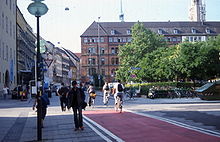
Bike path in the Residenzstraße
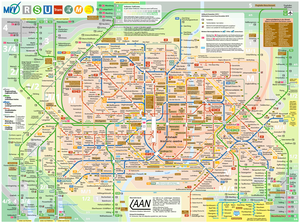
Rail network of the Munich Transport and Tariff Association with Metrobus lines
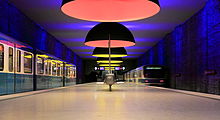
Subway station Westfriedhof
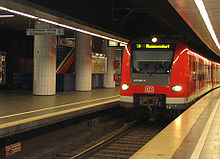
S-Bahn station Marienplatz
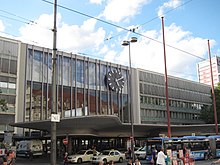
Munich Central Station (before the demolition of the old building in 2019)

Munich East Station / Ostbahnhof
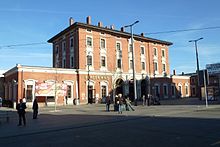
Munich-Pasing train station

Munich Airport
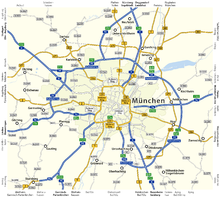
Freeways and Mittlerer Ring
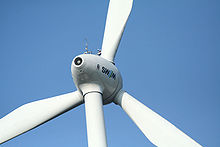
Wind power plant Fröttmaning of SWM on the Fröttmaning mountain

Olympic Tower
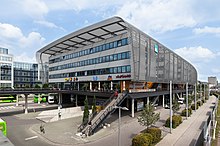
Front view of the Munich Central Bus Station from the Hackerbrücke (2014).
Public facilities
Various offices, courts as well as corporations and public-law institutions have their headquarters in Munich, including the Government of Upper Bavaria and the European Patent Office. The Munich city administration is divided into eleven specialized departments and has numerous office buildings in the city area.
In many areas of the public service (e.g. clinics, police, tax offices) there is a shortage of personnel, as Munich is too expensive for members of the lower to middle salary and remuneration groups due to the high cost of living and is therefore a decidedly unattractive place to work. As a result, the Schutzpolizei (protective police), for example, are staffed mainly by career starters, since almost every police officer from all over Bavaria has to start his service there first before he can be transferred back to his home region. The Munich tax office has largely outsourced file processing to processing centers in Deggendorf, Dillingen, Eichstätt, Ingolstadt, Passau, Straubing and Zwiesel.
Police
→ Main article: Munich Police Headquarters
The Munich Police Headquarters, which is responsible for the city and district of Munich and partially for the district of Starnberg, has its headquarters at Ettstrasse 2-4.The city had 5,575 police officers in 2019.
Fire department
→ Main article: Munich Fire Department
Munich has a professional fire department with ten fire stations and 22 volunteer fire departments.
Courts and prosecutors
See also: List of courts in Munich
Munich is an important location for courts in Bavaria, such as the Bavarian Constitutional Court, the Bavarian Administrative Court and the Bavarian State Social Court. The Federal Fiscal Court as one of the five highestcourts in Germany as well as the Federal Patent Court are also located in Munich. The Palace of Justice at the Stachus dominates the cityscape of downtown Munich. This is where, for example, the trials of the members of the White Rose resistance group took place in 1943 before the People's Court, which had traveled from Berlin especially for the occasion.
· 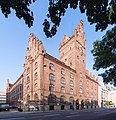
New judicial building with the Bavarian Constitutional Court and the Munich Higher Regional Court
· _(2019).jpg)
Palace of Justice, Munich Regional Court I
·
New Maxburg District Court and Munich Regional Court I
· 
Munich-Stadelheim Prison
Correctional facilities
There is one correctional facility (JVA) in Munich: The Munich-Stadelheim correctional facility is the largest prison authority in Bavaria. Juvenile and women's detention takes place in a branch office in the immediate vicinity of the main campus.
Public safety and order
The security authorities in Munich are responsible for maintaining public safety and public order. These include the District Administration Department and the Bavarian State Police including the Security Guard (originally the Munich Police Headquarters). In 2019, 90,229 crimes were reported in Munich.
"In terms of the crime rate of total criminal offenses, Munich is the safest municipality among major German cities with over 200,000 inhabitants. In 2013, 7,395 crimes per 100,000 inhabitants were recorded in Munich. In a long-term comparison of the past ten years, the total number of crimes has declined while the population has increased. The clearance rate was 62.5%."
- City of Munich, Directorate, Office for Statistics.
On July 22, 2016, an attack occurred in the Moosach district of Munich, killing nine people and injuring others.

Old Palace of Justice
Sports
Olympic Games
The biggest sporting event in Munich was the 1972 Olympic Games. The city had applied for the 2018 Winter Olympics and lost out to the South Korean city of Pyeongchang, which was chosen in the first round of voting. The council initiative to re-bid for the 2022 Winter Games failed in a referendum.
Sports facilities
In the north of the city lies the Olympic Park, built for the 1972 Olympic Games. The ensemble of the Olympic Stadium, the Olympic Swimming Hall and the Olympic Hall is world-famous, especially because of the daring tent roof construction, which fits perfectly into the hilly landscape of the surrounding park. The Olympic Ice Stadium, which opened back in 1967, is also located here. The Olympic sports facilities also include a regatta course on the northern outskirts of the city in Oberschleißheim. Until 2005, the Olympic Stadium was the home ground of FC Bayern München and, for a time, TSV 1860 München.
In May 2005, the Allianz Arena, located at the north end of the city, was opened to host FC Bayern Munich's home games. The arena, which holds 75,000 spectators (69,000 internationally), hosted the opening match of the 2006 World Cup and other games. The most traditional and oldest major sports venue in Munich is the municipal stadium on Grünwalder Straße. TSV 1860 München plays its home games there (with several interruptions), as did FC Bayern München until 1972.
The DAV Climbing and Bouldering Center Munich South, the world's largest artificial climbing facility with two climbing and bouldering halls and several outdoor facilities, is located in Munich's Sendling district.
Public sports facilities for the population are primarily the district sports facilities set up in the individual city districts and boroughs and the Munich swimming pools. For equestrian sports, there is the Daglfing harness racing track and the Riem gallop racing track.
Sports clubs
Probably the best known sports club in Munich is the German record champion in men's soccer, FC Bayern Munich, which has played continuously in the Bundesliga since 1965. The second major soccer club is TSV 1860 Munich, which also played in the Bundesliga for several years. The three-time German champion EHC Red Bull München represents Munich in ice hockey, Münchner SC in field and indoor field hockey, and the Munich Cowboys and the München Rangers in American football. Along with Frankfurt am Main, Munich was also the city where Australian football developed in Germany in the mid-1990s. Along with the Frankfurt Redbacks, the Munich Kangaroos were one of the founding clubs of the Australian Football League Germany (AFLG).
TSV Milbertshofen was twice German team champion in table tennis, German champion and cup winner in volleyball, German cup winner and European cup winner in handball. In addition, the basketball department of FC Bayern Munich is represented in the Basketball Bundesliga, having already won two German championships and a cup victory in the 1950s and 1960s. The MRRC Munich, as the largest Bavarian triathlon club, is represented in the Triathlon Bundesliga with one women's and one men's team.
The snooker club 1st Munich SC plays in the 2nd Snooker Bundesliga. The Munich Animals are 12-time German champions in powerchair field hockey and have played continuously in the top division since the founding of the Bundesliga.
Urban sports
Regular running events include the Munich Marathon in October, the Half Marathon and ISPO Munich Night Run in April, the Wings for Life World Run Munich in May, the Munich City Run in June, the Munich Company Run in July and the New Year's Eve Run Munich on December 31, as well as the Spartan Race Sprint, the Olympic Alm Cross Run and the Best Times Marathon.
Munich is also the world's most famous place for river surfing due to the inner-city standing wave in the Eisbach, which is frequented by surfers at all times of the day and all year round. Two other well-known spots for river surfing are located along the Isar River.
In winter, ice bathers meet at the Eisbach and the Isar.
Alpine sports
Due to its proximity to the Alps, Munich is a city of mountaineers and skiers with a long tradition, as evidenced by the so-called Munich Hausberge.
The Club Arc Alpin (CAA) as the umbrella organization of the Alpine clubs of all Alpine countries as well as the German Alpine Club (DAV) have their headquarters in Munich.
The German Alpine Club has 19 sections in Munich, of which the Munich Section and Oberland Section are the largest - these are also the largest sports clubs in Germany after FC Bayern Munich.
Other DAV sections based in Munich are the Gay Outdoor Club Munich, Section Bergland, Section Hochland, Section Universitätssportclub München, Section Turner-Alpenkränzchen, Section Bergbund München, Section Bergfreunde München, Section Männer-Turnverein München, Section Isartal, Section Königsberg (founded in Königsberg), Section Karpaten (founded in Hermannstadt), Academic Section Munich, Section Alpiner Ski-Club München, Section Bodenschneid, Section Edelweiß München, Section Achensee, Section Firnland.
Another alpine club is the Academic Alpine Club Munich, which is not affiliated with the DAV.
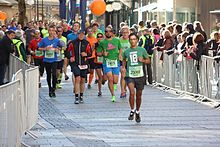
Munich Marathon
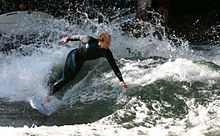
Surfer on the Eisbach wave

Allianz Arena
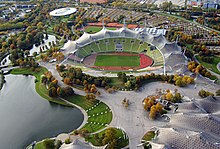
Olympic Stadium Munich
See also
![]()
Portal: Munich - Overview of Wikipedia content on the topic Munich
Questions and Answers
Q: What is the population of Munich?
A: The population of Munich is 1,407,000.
Q: What is the metropolitan area of Munich?
A: The metropolitan area of Munich includes the city itself and all the suburbs around it, and has about 2.6 million people in it.
Q: What type of climate does Munich have?
A: Munich has an oceanic climate (Cfb in the Koeppen climate classification).
Q: Where is Munich located?
A: Munich is located in Germany and is the capital of Bavaria.
Q: How many people are in the metropolitan area of Munich?
A: There are approximately 2.6 million people in the metropolitan area of Munich.
Q: What cities are bigger than Munich in Germany?
A: Berlin and Hamburg are both bigger than Munich in Germany.
Search within the encyclopedia


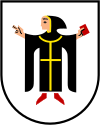
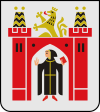
.svg.png)
